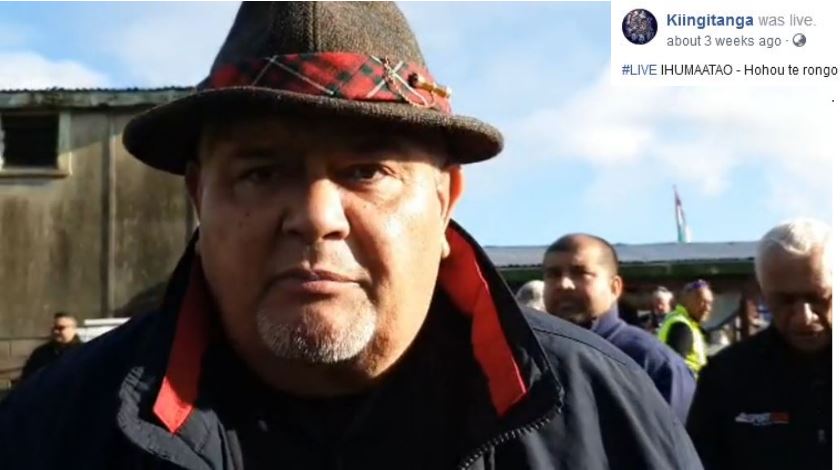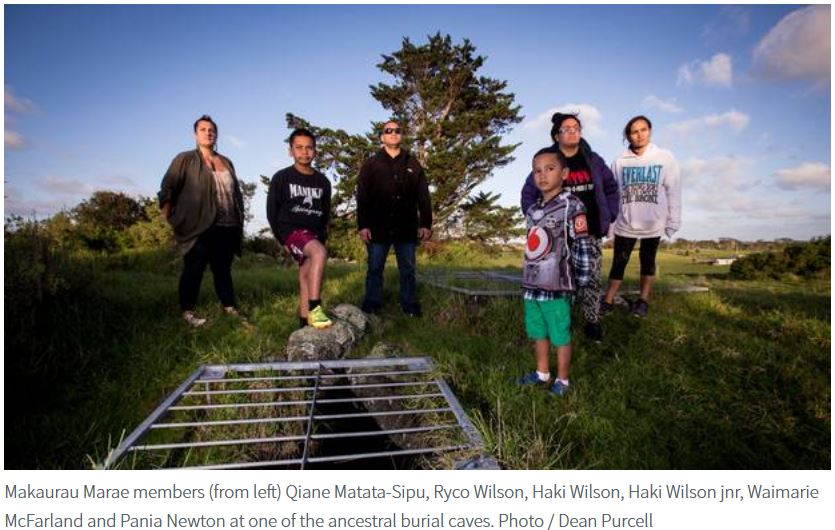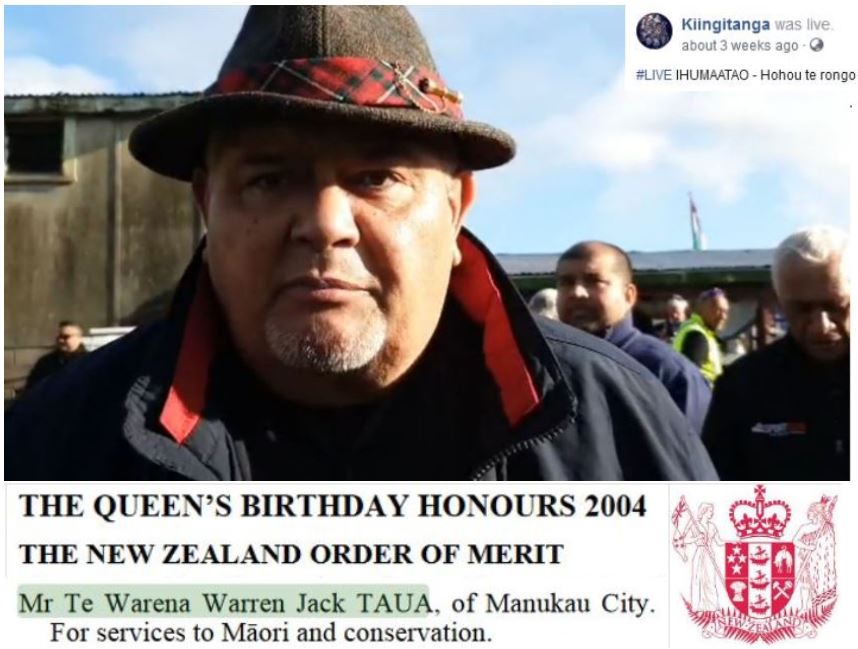
By Snoopman — September 6, 2019 at 1:00 pm
[updated 9 August 2019]
The recipient of the New Zealand Order of Merit in 2004, Mr Te Warena Warren Jack Taua, is the key opponent in a battle with ‘the six cousins’ of Ihumātao, their campaign group and the papakāinga, or village, – who dared to disobey his ‘authority’. ‘The six cousins’ formed SOUL (or Save Our Unique Landscapes) in 2015 to fight Fletcher Building’s planned residential development on historically significant land, near Auckland International Airport; land that even Mr Taua once testified was sacred. Mr Taua also dismisses ‘the six cousins’ for lacking mandated mana whenua status, talks over them in interviews, and seethes at SOUL’s criticism of him for working with Fletcher Building. Ironically, the transnational bank-owned construction company coerced Heritage New Zealand into passing its archaeological application in 2017. Fletcher Building’s mainstay kaumātua has been Te Warena Taua ever since he openly supported the Fletcher Residential’s proposed housing project at Ihumātao, when he spoke on 27 August 2015 at the Auckland Council Chambers in opposition to SOUL’s petition of 4000 signatures.
Moreover, Mr Taua has assumed authoritarian status in the Ihumātao community by chairing three committees across three iwi/hapū groups on one marae. At the same time, he has exposed his own iwi – Te Kawerau ā Maki – to protracted litigation over a deal he entered into with a company called Tahi Enterprises. Tahi claim they have a 35% stake in all the tribe’s future profits and 4% of its assets in return for funding the iwi’s Treaty settlements claims to the tune of $1.3 million. Te Kawerau ā Maki Iwi trustees claim Mr Taua had no mandate to contract, while they acknowledge Tahi advanced $1.3 million to their iwi to help their Waitangi Treaty settlement claims in exchange for joint venture rights.
Furthermore, while Mr Taua has been chairing three committees across three iwi/hapū groups on one marae, the Chairman of the Environment Committee’s for both the Makaurau Marae and Te Kawerau Iwi Tribal Authority – Saul Brendon Roberts – was convicted of fraud in the Auckland High Court in March 2018. Roberts’ offending began when he was a trustee at Te Kawerau Iwi Tribal Authority in 2009. This investigation queries Warren Taua’s judgment in the last decade as a high profile kaumātua, his fitness to be chair of Makaurau Marae Māori Trust, and his claims that Te Kawerau ā Maki have mana whenua status over Ihumātao – while ‘the six cousins’ and their iwi/hapū supporters of the papakāinga at Ihumātao either do not, or are wrong-headed. Ironically, the six young cousins are of mixed Ngāti Te Ahiwaru, Te Ākitai, Ngāti Māhuta, Waiohua and Te Kawerau ā Maki descent.
The key finding of this exposé is this: SOUL’s four-year campaign amplified the risks for the mandated kaumātua that his secret deal with Tahi Enterprises would be exposed, would therefore, – unravel his crucial support of the Fletcher Building project, and would catastrophically destroy his accumulation of power and forever devalue the merits of his life’s-work for Te Kawerau ā Maki iwi. In light of what The Snoopman calls the Tahi vs Taua Scandal, the complications caused for Mr Taua by the six defiant cousins goes a long way to explain the deep irritation Mr Taua has felt about their so-called un-mandated group — SOUL — and to explain why he has been so dismissive of Pania Newton.
Three Chairs for Mr Taua
Mr Te Warena Warren Jack Taua has been the most visible Māori figure opposed to ‘the six cousins’ who formed the land protest and protection group, SOUL, to prevent the Fletcher Building consortium developing on an historic site at Ihumātao – with a hashtagged #Protect Ihumātao campaign brand. Taua is the chairman of three committees across three iwi/hapū groups at Makaurau Marae in Ihumātao; he is the spokesman for the Māori King in Tāmaki Makaurau, and has challenged the Crown, various Councils and Corporates since the early 1980s over developments, pollution and redress for colonization.
In 2012, Te Warena Taua opposed the settler Wallace Family’s company, Gavin H Wallace Limited, who sought to have the disputed land at Ōruarangi, Ihumātao, rezoned through an appeal to the Environment Court. The settler Wallace Family – who inherited confiscated land bought by their ancestor, Gavin Struthers Wallace, in 1866 at a Waste Lands Office auction – sought to have the existing rural land (known as ‘the Wallace Block’), designated as a ‘Future Development Zone’. Mr Taua stated in the 2012 Environment Court hearing that all land at Ōruarangi was wāhi tapu, or sacred. The Wallace Family’s appeal succeeded. The land was drawn within the Auckland Metropolitan Urban Limits. This move cancelled a protective Notice of Requirement placed by the Manukau City Council in 2007 over the Ōruarangi Block, supposedly as an interim move in preparation for designating the land as Public Open Space in proposed amendments to the Manukau District Plan. ‘The Wallace Block’ was now set on a trajectory for sale to a well-resourced developer, Fletcher Residential – a subsidiary of Fletcher Building Limited. With a Government and Council faced with a housing crisis in Tāmaki Makaurau/Auckland, everything on paper looked like the residential housing project would go according to plan – especially if Māori could be persuaded to support the proposal.
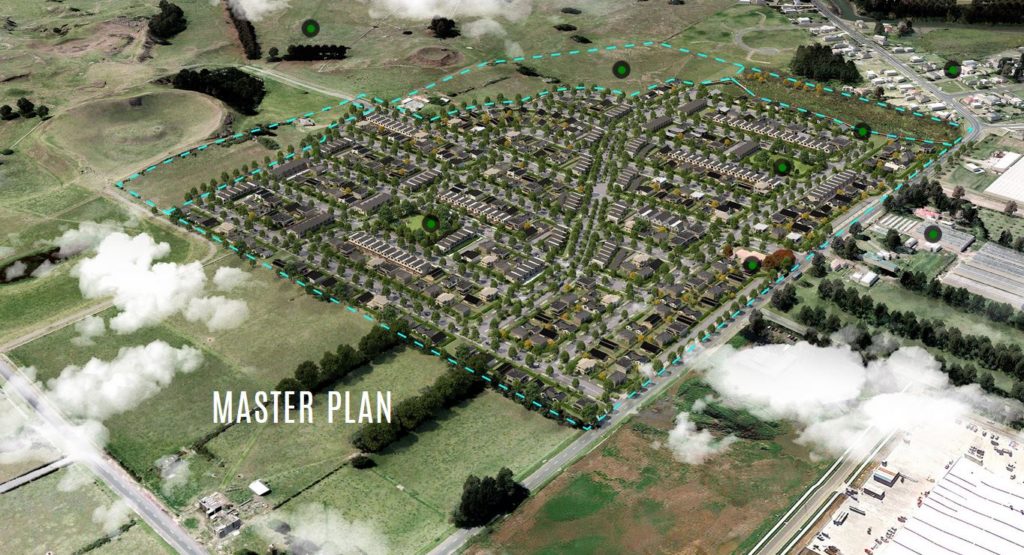
‘The six cousins’ — Waimarie McFarland, Qiane Matata-Sipu, Bobbi-Jo Pihema, Moana Waa, Haki Wilson, and Pania Newton — were tutored by their grandparents at Ihumātao so that they would learn the Māori language, tikanga Māori (or culture), and the history of the Manukau Region. In October 2015, Haki Wilson told the electronic zine e-Tangata, that at first the cousins believed their fight would be easy, thinking, “Cool as. We can do this!” But then, SOUL’s Protect Ihumātao campaign got “heavy”, as the firepower of their opponents appeared to overshadow the group’s efforts – including Newton’s occupation of the whenua, known more locally as Puketāpapa, a volcanic scoria stone’s throw from one of two of her ancestral maunga, Te Puketāpapatanga-a-Hape (or Pukeiti), the smallest cone in Auckland’s volcanic field. Newton’s – and her cousins’ – other ancestral maunga are the main volcanic cones of Ōtuataua and Maungataketake to the south, which were quarried in the 1950s and 1960s, the scoria being used for building work – including the runways for Auckland Airport. Once, Ōtuataua acted as a natural fortification for Ihumātao’s first pā, with the lower slopes of the volcano supporting intensive Māori gardening. The remnant of Ōtuataua is now part of the Ōtuataua Stonefields Historic Reserve. Further out at Ihumātao Point – Maungataketake – was not so fortunate because this volcanic mountain was also quarried for the airport runways, and while the cone has completely disappeared, the quarrying is set to continue until there is nothing left to take.

Despite the fact that he is the chairman of three committees at Makaurau Marae in Ihumātao, Mr Taua had denied he even knows Pania Newton and had even claimed she was a stranger who came into the community with her protest, on TVNZ’s Marae on July 28 2019. Meanwhile, Newton has been a regular participant of hui, gatherings and celebrations and even at powhiri at Makaurau Marae with Taua in attendance. Mr Taua has repeatedly drawn on his standing with the authorities, including the Crown, the Police, the Council, and the Courts, and they all have shown great respect for him – until SOUL’s supporters swelled the occupation in late July 2019, following a 200-strong Police operation in support of an eviction notice-wielding Court bailiff on July 23.
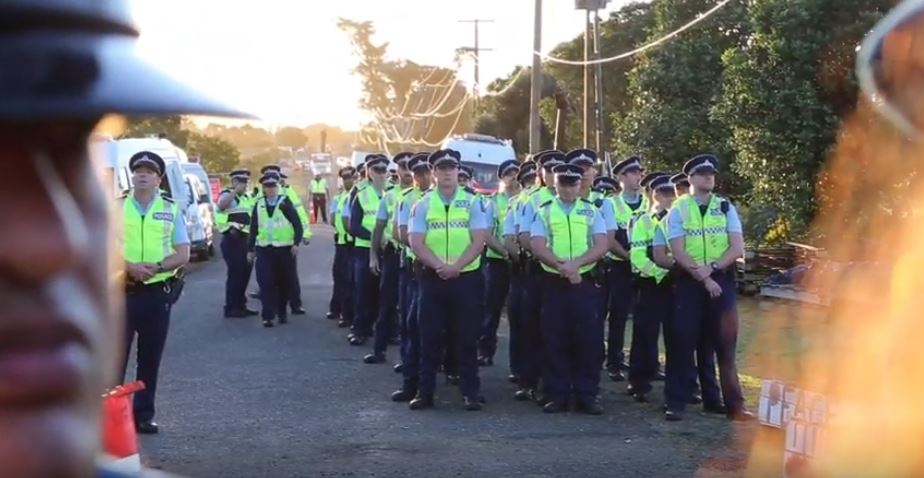
Yet, Taua’s dealings with Fletcher Building calls into question his judgment that he could not stop the development, since his apparent exclusion of Makaurau Marae meant he was really saying he could not fight a transnational building consortium on his own. His posturing that he could not prevent the development – because Fletcher Building had an exclusive right to buy the land from the Wallace-Blackwell Family – spoke more about the mandated kaumātua as an autocratic character than the objective situation. Warren Taua dismissed consensus-built mandates from the local marae while steering queries away from the question why it was so important for a developer to have a mandated kaumātua on board, if such a mandated kaumātua had no power to stop a private land deal. Moreover, Taua’s dealings with a company called Tahi Enterprises also raises questions about the reknowned kaumātua of Makaurau Marae, since he entered into two agreements with Tahi in 2007 and 2008 to borrow up to $2 million to assist with the iwi’s Treaty claims. In return, Tahi would receive a 35% stake in all Te Kawerau ā Maki enterprises in perpetuity and 4% of assets. Furthermore, Taua’s position as chair on three committees across three iwi/hapū groups on one marae is “unprecedented and unwise, particularly where resource disparities exist” – as Dr Rawiri Taonui wrote in a recent Waatea News article, “Ihumātao | Tangata Whenua vs Mana Whenua”.

Taua became chair of the Te Kawerau ā Maki Iwi Tribal Authority in 2008, the Makaurau Marae Māori Trust in 2013, and the Te Kawerau Settlement Trust in 2014. At Ihumātao, the Makaurau Marae is the base of hapū groups of Te Ahiwaru Waiohua and Ngāti Mahuta tribes. Te Kawerau ā Maki are a marae-less iwi, despite their presence in Ihumātao, as the tribe’s own Deed of Settlement signed in 2014 with the Crown states. Moreover, Dr Taonui points out that Te Ahiwaru Waiohua and Ngāti Mahuta were excluded in the Tāmaki Makaurau Collective Settlement – initiated at the end of 2008 by then-Minister of Treaty Negotiations, Chris Finlayson (2008-2017), in the Key-National Government – which recognized only 13 mana whenua groups in the Tāmaki Makaurau Collective Redress Deed reached in 2012. The better resourced iwi groups were in the fold, while those based at Makaurau Marae were excluded. Dr Taonui says this is because the process was rushed. Perhaps. But, then seeing the development that has occurred in the area since the beginning of 2009 with huge transnational firms setting up logistics warehouses near Auckland’s airport a short distance away, you have to wonder if it was a deliberate omission. Chris Finlayson’s re-appearance in the news media just prior to SOUL’s hikoi to the Prime Minister’s electorate office on August 22 to smugly dog-whistle that Newton should walk to Tainui iwi to buy the land for a Novotel Hotel with an 18-hole golf course – speaks loudly that he took no responsibility for excluding Te Ahiwaru Waiohua and Ngati Mahuta from being recognized as mana whenua.

Minister of Treaty-Settlements-Past: Chris Finlayson suggests that Tainui could buy the Ihumātao land and develop it with a Novotel Hotel and 18-hole golf course while thinking about Pania Newton’s concerns. While he was too busy inoculating his dog-whistling with polite racism, Mr Finlayson neglected to fess-up that the 13 tribes he mandated for Tāmaki Makaurau/Auckland excluded Te Ahiwaru Waiohua and Ngati Mahuta at Ihumātao.
Dr Taonui pointed out a further risk to one person chairing three committees across three iwi/hapū groups on one marae, and that is “without clear electoral processes trustees or chairs act upon their own volition.”
Buying-in with a Transnational Bank-owned Construction Cartel
Indeed, Taua’s dealings with Fletcher Building calls into question his judgment that he could not stop the development, since his apparent exclusion of Makaurau Marae meant he was really saying that to fight a transnational building consortium – he would have needed an open, freely consenting mandate from the paepae at Ihumātao. Instead, Mr Taua gained what he construed as his ‘mandate’ to support the Fletcher housing project from what appears to have been a clique meeting in secret.
In his excellent investigation into how ‘the Wallace Block’ came to gain Special Housing Area status – “Ihumātao | He Raupatu Tuarua | A Second Confiscation” – Dr Rawiri Taonui shows the collusion between the Fletcher construction company, the Auckland Council and the Crown. At some point in 2014, Mr Taua became a party to this collusion. Dr Taonui summarised the mysterious processes that led to ‘the Wallace Block’ at Ihumātao becoming Special Housing Area 62 (SHA62) and how Fletcher Building was able to whisk off to the Overseas Investment Office to gain approval without genuine deliberation, investigation and implementation of discovery-revealing consultation with the relevant iwi/hapū groups. Dr Taonui wrote:
“In November 2013, Fletcher Residential advised the Council that it intended to build at Ōruarangi. Council’s Housing Projects Office prepared a confidential brief titled the ‘The Wallace Block’. The Māngere Ōtāhuhu Local Board discussed and rejected the proposal on 19 March 2014. The following day, Fletcher and the Blackwells entered into a sale and purchase agreement for $19 million. Eleven days later, Fletcher, as a majority overseas company, applied for Overseas Investment Office (OIO) approval of the sale. Two days after that, the Auckland Council Development Committee, with the public excluded and minutes secret, approved the Fletcher proposal to build 520 houses with an end of 2014 start date. An updated Wallace Report included a short section saying, ‘the Local Board opposes the project’ to which the Housing Projects Office added ‘recommend that the project proceed’.
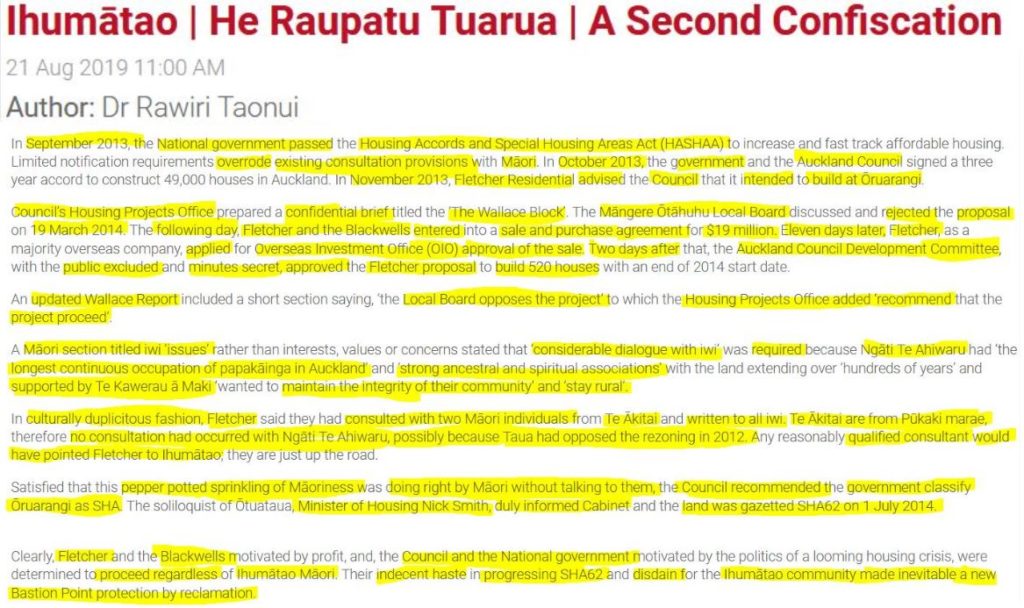
“A Māori section titled iwi ‘issues’ rather than interests, values or concerns stated that ‘considerable dialogue with iwi’ was required because Ngāti Te Ahiwaru had ‘the longest continuous occupation of papakāinga in Auckland’ and ‘strong ancestral and spiritual associations’ with the land extending over ‘hundreds of years’ and supported by Te Kawerau ā Maki ‘wanted to maintain the integrity of their community’ and ‘stay rural’. In culturally duplicitous fashion, Fletcher said they had consulted with two Māori individuals from Te Ākitai and written to all iwi. Te Ākitai are from Pūkaki marae, therefore no consultation had occurred with Ngāti Te Ahiwaru, possibly because Taua had opposed the rezoning in 2012. Any reasonably qualified consultant would have pointed Fletcher to Ihumātao; they are just up the road. Satisfied that this pepper potted sprinkling of Māoriness was doing right by Māori without talking to them, the Council recommended the government classify Ōruarangi as SHA. The soliloquist of Ōtuataua, Minister of Housing Nick Smith, duly informed Cabinet and the land was gazetted SHA62 on 1 July 2014.”
When the Makaurau Marae community of Ihumātao met in February 2015 to discuss the Fletcher development, it was clear that Te Warena Taua was in support of the project and it also appeared that he was under the sway of Fletcher Building. In a June 2015 news article, “480 homes planned for Maori burial ground”, the Otago Daily Times reported Te Warena Taua had switched from opposing to accepting the development because he claimed he could not stop it. “It’s privately owned land. If Fletchers doesn’t develop it, someone else will,” Mr Taua told the newspaper. Mr Taua said on TVNZ‘s Marae that he visited Ailsa Blackwell, claiming he sought to buy the property from her, since the iwi had money because it had just got its Treaty Settlement. Ailsa Blackwell evidently revealed a roadblock to Warren Taua’s alleged plan to buy land confiscated off other iwi with his own tribe’s settlement cash. Blackwell said she had an agreement to sell the property to Fletcher Building (which was on 20 March 2014), and so he claims there was nothing he could to stop the sale. However, Mr Taua’s reasoning is not consistent with the facts on the whenua.
The deal the Wallace-Blackwell Family had with the construction consortium was a standard sale and purchase agreement conditional on Fletcher Building gaining approval from the Council, with Special Housing Area Designation, the Overseas Investment Office and Heritage New Zealand approval. For a mandated kaumātua with a reputation for fighting developers, Councils and the Crown – Mr Taua’s capitulation is remarkable. Because his dealings with Fletcher Building followed his rupture with Tahi Enterprises, this is more reason to imagine that ‘Ihumātao’ may well go down in New Zealand’s Neo-Colonial history as the watershed moment, that marked the countdown of numbered days to when Māori élite could no longer make crucial resource decisions in secret proceedings with their élite counterparts – foreign and domestic – especially te Pākehā ‘Old Boys Network’. Besides, Taua’s iwi only received $6.5 million in cash, which is the amount the Wallace-Blackwell family turned down from Auckland Council after the law-making local government authority lost ‘the Wallace Block’ rezoning battle in the Environment Court in 2012. Moreover, ‘the Wallace Block’ sale and purchase agreement was for a sum of $19,000,000. Therefore, Warren Taua’s claim that there was nothing he could do to stop the development, because Fletcher Building had an exclusive agreement with the Wallace family could only stand-up if it were not scrutinized for its in-built lying by omission. Mr Taua’s neither had enough cash from his iwi’s then-recent Treaty Settlement to outbid Fletcher Building not even with the $1.3 million from Tahi Enterprises – with whom Taua severed ties as soon as the tribe signed worth the Crown. Furthermore, the conditional sale and purchase agreement provided an opportunity for Mr Taua, since he was by then a mandated kaumātua who controlled the chairmanship positions on three committees across three iwi/hapū groups on the marae located at ‘Ihumātao’. Fletcher Building had not consulted him. By his own admission, he was looking for corporate partners to help his iwi develop their modest assets and limited cash settlement.
Mr Taua, it seems, burned his bridge with Dianne Lee and Tahi Enterprises.

On TVNZ’s Marae, July 28 2019, Mr Taua said he visited Mrs Blackwell to see if he could buy ‘the Wallace Block’, but he evidently was told the sale had already happened. Taua added there was nothing he could do legally to intervene and so he turned his efforts to mitigation. Mr Taua said:
“I went to see Ailsa, the owner of the land to try and buy the land back. We had money to buy the land back. She couldn’t. She was very clear that if they sell the land, they could only sell it to Fletchers. And there was a legal agreement. So the best thing was to see what we could get back for our people. Land is coming back – eight hectares. Now that is coming back at no cost to us. But also homes for people. Now, you know what we’ve fought long and hard. I’ve settled the iwi with the Crown and I know the work and how hard it is to get land back. It’s not going to come any other way.” – Te Warena Taua, Marae.
After his encounter Aisla Blackwell, Mr Taua says he next visited Fletcher’s Steve Evans. Mr Taua said he did so to get a law change to change things, he told the Auckland Council on August 27 2015 when SOUL petitioned the Pākehā ‘Old Boys Network’ that controls the Town Hall. Warren Taua has also claimed he met with Fletcher Building to develop a business partnership for his iwi – as he had said many times, before Te Karere reporter Te Rina Kowhai aired the story of Mr Taua’s joint venture deal with Dianne Lee of Tahi Enterprises – before a wider audience than The Snoopman could reach, even with his gamers’ keyboard. Like his alleged visit to Ailsa Blackwell, his meeting with Mr Evans of Fletcher Building appears to have occurred after Te Kawerau ā Maki signed a Treaty settlement with the Neo-Colonial Crown on 22 February 2014 and after the Wallace-Blackwell family company signed with Fletchers on 20 March 2014. Most of the iwi seems to have been unaware that the joint venture deal with Tahi Enterprises appears to have bound Te Kawerau ā Maki to share a 35% stake in all the tribe’s future profits with Tahi. What the Makaurau Marae community did not know in February 2015, when they first met to discuss planned development, was how close Taua was to the orbit of Fletcher Building.
Gavin H Wallace Ltd had asked Auckland Council for the land to be designated a Special Housing Area, according to Leonie Hayden in her excellent investigative piece, When Worlds Collide, published in NZ Geographic – although she does not state when the Wallace land company made the request. According to the Overseas Investment Office, Gavin H Wallace Ltd applied in July 2013 to have the land designated as a Special Housing Area. Fletcher Residential CEO Steve Evans says the construction company did not apply for the SHA status, but supported that process. Evans’s vague answer to Ian Sinclair in 2016 for TVNZ‘s Sunday programme was in place of saying Fletcher Residential advised Council in November 2013, that it intended to build at Ōruarangi.
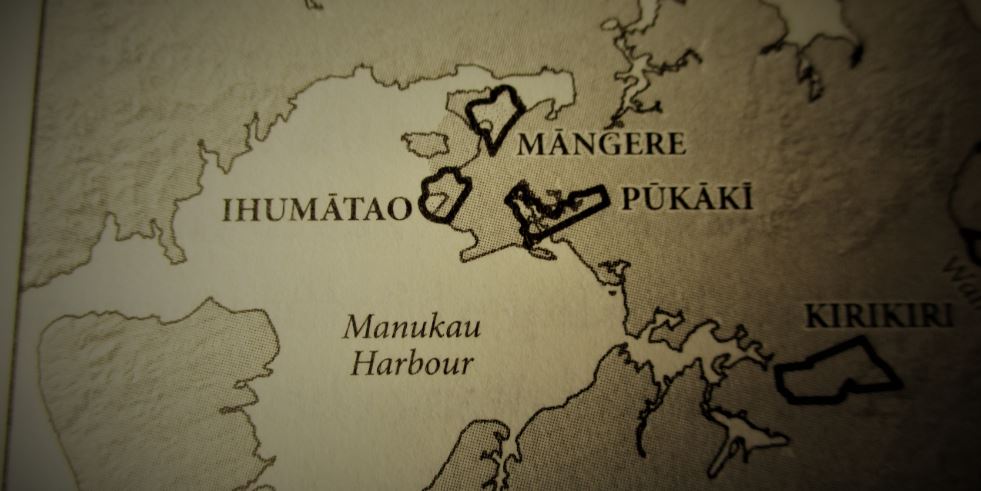
Confiscated from Māori: Between 1863-66, most of the 1100-acre block at Ihumātao was confiscated, with all but a few of the inhabitants forced to move to join their relatives in the Waikato. By the of the century, those who returned to Ihumātao were forced to subsist on a 50 acre reservation.
Conspicuously, a New Zealand Herald article, 480 homes planned for Maori burial site, missed the significance of the unseemly haste underpinning Fletcher Building’s Overseas Investment Office (OIO) application. In this mid-June 2015 article, Heritage NZ Maori manager Te Kenehi Teira said the development would need an archaeological authority. Teira said, “It will end up on my desk at some stage. I will take it straight to the Maori Heritage Council for a decision because of the magnitude of the place.” In other words, a sale in rural ‘sensitive’ land adjacent to a Hisotric Reserve of significance to Māori gained approval from the Overseas Invetsment Office – with two ministerial waivers – prior to Heritage NZ and Maori Heritage Council assessing the application. This process seems to be in the wrong order and appears to have been constructed to aid speedy land sales to wealthy foreign buyers, which creates skyward structural pressures on property values, making lands unaffordable for Māori and other New Zealanders to buy to forge self-determining communities not subject to huge commercial pressures.
In other words, the Overseas Investment Office (OIO) application could have been contested since Te Warena Taua, either had not been consulted when Fletcher Building filed its application at the end of March 2014 – despite Mr Taua being the chair of Makaurau Marae Māori Trust since 2013. Or, Mr Taua knew about the land deal when the ink was still drying on, or about, March 20 2014, or he learned of it in early-to-mid-September 2014. The timing of when Mr Taua actually went to the Wallace Homestead at 561 Oruarangi Road, Ihumātao, has been vague in many accounts, including Mr Taua’s own public statements. However, Emily Karaka – who accompanied Te Warena Taua to the kaitiaki village at Ihumātao on the morning of the eviction, July 23 2019 – stated on Facebook that Mr Taua visited Ailsa Blackwell at the Wallace Homestead the day her son, John Wallace Blackwell, signed the conditional sale and purchase agreement with Fletcher Building. But Karaka recalled that Ailsa Blackwell said to Mr Taua to call her son, but that when he did so, the deal had been signed about a half hour before he rang John Wallace Blackwell. Mr Taua’s alleged visit to Ailsa Blackwell at the Wallace Homestead would appear to have taken place on March 20 2014, the signing date of the conditional agreement – if Emily Karaka’s recollection is to be believed.

Yet, approximately six months later, on 17 September 2014, Radio New Zealand reported Te Warena Taua threatening the Auckland Council with court action because it had not consulted with Te Kawerau ā Maki people living at Ihumātao. In its report, Radio NZ gazetted that the Auckland Council advised at the time that it was now Fletcher Building to consult with the tribe directly, while Fletchers evidently said it is prepared to talk with the mana whenua. Strangely, this report, “Court threat over housing accord”, recorded that the Fletcher development project up to 480 houses would be built. Strange, because Mr Taua has often bragged that it was through his efforts in negotiating a better deal for his iwi, that he gained concessions from Fletcher Building – including the construction firm agreeing to reduce the number of houses from 520 down to 480. This figure of 480 homes is not only mentioned in this RNZ report of 17 September 2014. As we shall see, it was also reported that Fletcher Building’s Overseas Investment Office application stated up to 480 houses would be built. As Dr Raonui reported on Waatea News, Fletcher Building’s Overseas Investment Office (OIO) application was filed eleven days after the Wallace-Blackwell Family entered into a sale and purchase agreement for $19 million on March 20 2014.
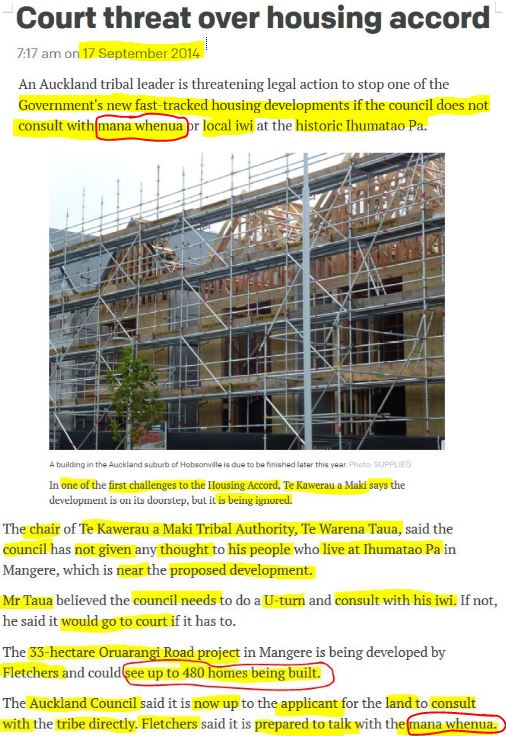
Stranger still is the fact that Mr Taua was complaining that the Auckland Council has not consulted with him as the chief of his iwi – whom he claims are the mana whenua of Ihumātao. And in response, the Auckland Council passes the proverbial buck to the Housing Accord applicant – Fletcher Building to now consult with the tribe and in turn Fletcher Building says it is willing to talk with the “mana whenua”.
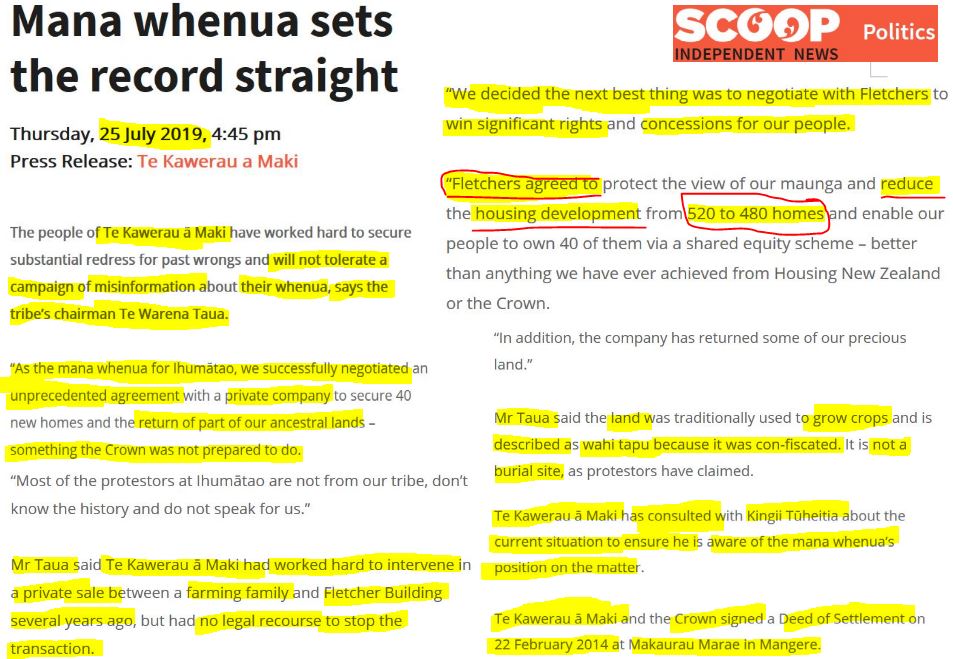
This metadata of reduced number of houses to be built also turns up as part of Te Warena Taua’s narrative spinning two days after he accompanied Police, Fletcher Building CEO Steve Evans, and numerous Māori Wardens to evict the Ihumātao occupation group. In a press release of 25 July 2019 attributed to Te Kawerau ā Maki, it claimed Mr Taua had said that his iwi had worked hard to intervene in a private sale between a farming family and Fletcher Building several years ago, but had no legal recourse to stop the transaction. However, Te Kawerau ā Maki supplied no evidence to back up Mr Taua’s assertion that the iwi had actually “worked hard to intervene in a private sale between a farming family and Fletcher Building several years ago”.
“We decided the next best thing was to negotiate with Fletchers to win significant rights and concessions for our people. Fletchers agreed to protect the view of our maunga and reduce the housing development from 520 to 480 homes and enable our people to own 40 of them via a shared equity scheme – better than anything we have ever achieved from Housing New Zealand or the Crown.”
Thus, Mr Taua claimed in the press release head-lined “Mana whenua sets the record straight”, that as a result of his efforts, Fletcher Building reduced the number of houses from 520 to 480.
Instead of battling with the Auckland Council – as the chairman of Te Kawerau a Maki Tribal Authority said he would in mid-September 2014 if the local authority did not do a u-turn – Te Warena Taua would go on, not only to write a Cultural Impact Assessment in 2015 in support of Fletcher Building’s development. He may also have been paid for not fighting the development in the process. In his Waatea News investigation, “Ihumātao | He Raupatu Tuarua | A Second Confiscation”, Dr Rawiri Raonui mentions that during an Accord Territorial Authority hearing in May 2016, Fletcher Building stated that Te Ākitai Waiohua and the Te Kawerau Iwi Authority and Makaurau Marae Māori Trust had completed Cultural Impacts Assessments for the construction company. Te Ākitai Waiohua are from Pūkaki Marae. While they are also mana whenua at Ihumātao, it is through inter-marriage. This means their connection to Ihumātao is more about whose bones they jump than about whose bones were buried on the whenua before Ailsa Blackwell, the grand-daughter of the original settler-occupier, Gavin Struthers Wallace, was a party to stealing them for a school show-and-tell talk in 1940. Crucially, the apparent readiness of the two representatives of Te Ākitai Waiohua at Pūkaki to sign off on the deal shows either flippancy or an irresponsible attitude given the long history of Pākehā companies persuading Māori to sign pieces of paper to approve land developments that later cause rifts among related Māori communities.

Mr Taua actually presented in favour of the Fletcher Residential proposal at Auckland Council meeting on 27 August 2015, while Pania Newton led a group of 200-supporters to present their 400-signature petition requesting the Council to revoke the Special Housing Area (SHA-62) fast-track zoning that prevented SOUL from opposing the development through many official processes. Taua revealed the Fletcher development would have a mana whenua-owned buffer zone between the housing the stonefields, ownership of half a maunga, and a possible housing partnership (later 40 houses) and cultural centre. Pania Newton spoke of the ancestral history, the historical suffering of the people at Ihumātao papakāinga, suggested other sites for housing development and asked Council to revoke SHA62. In essence, the then-25 year-old Māori graduate of Auckland University Law School politely told the Pākehā Councillors off, informing them that the Ihumātao community became aware of the SHA zoning after they saw new survey pegs on ‘the Wallace Block’, as Ian Sinclair’s Sunday programme from 2016 showed. Te Warena Taua told the Council, “The only reason we begun to talk with Fletchers was that to change things, there needed to be a – [pause] a law change.” But, of course, Mr Taua was not at the Auckland Council to lobby for a law change – because he had already capitulated. Letters in support for each side of the dispute from the Makaurau Marae Committee were presented – further revealing the deep divisions within Ihumātao.
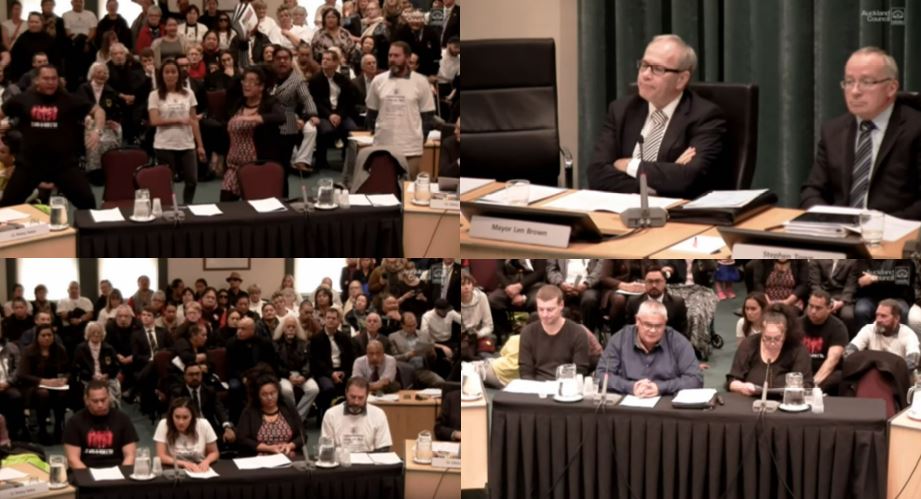
In his piece for Waatea News, Ihumātao | He Raupatu Tuarua | A Second Confiscation, Dr Rawiri Raonui sums up what happened next:
More crucially, a letter was tabled from Minister of Housing Nick Smith, who concerned about the political ramifications of a reversal for National’s flagship HASHAA policy, said that because SHAs were activated by Orders in Council only he as Minister could revoke them. The motion was defeated 12 votes to five. Thirteen days later, Associate Minister of Finance Jonathan Coleman and Minister for Land Information New Zealand Michael Woodhouse approved the OIO application.
The coordinated signing off on the Overseas Investment Office application by the Associate Minister of Finance Jonathan Coleman and Minister for Land Information New Zealand Michael Woodhouse – thirteen days after the Auckland Council vote against revoking SHA designation – actually shows SOUL’s showdown on August 27 2015 was a critical institutional hurdle for the transnational banked-owned Fletcher Building corporation to leap over. Therefore, Mr Taua’s support as the ‘mandated kaumātua’ on three committees across three iwi/hapū groups on one marae, supplied the essential ‘Maoriness’ – as Dr Rawiri Raonui put it – that the Auckland Council, and subsequently, the Overseas Investment Office, Heritage New Zealand, and the Environment Court needed to grant their approval.
Furthermore, Taua’s judgment in continuing to work with Fletcher Building is questionable given that it is publicly known that Fletcher Building threatened Heritage New Zealand after being turned down on two applications for archaeological approval. The construction consortium stated it would seek a judicial review if its third application was unsuccessful, as Dr Taonui noted in his article “Ihumātao | He Raupatu Tuarua | A Second Confiscation” on Waatea News. Heritage New Zealand granted the authority in September 2017. Heritage New Zealand’s capitulation to Fletcher Building’s coercive threat meant it abdicated its responsibility to protect a site of national historical significance.

The impact on the Ihumātao community of Mr Taua chairing three committees across three iwi/hapū groups on one marae can be seen in the Auckland Council’s Accord Territorial Authority plan variation report for the Oruarangi Special Housing Area at Ihumātao, dated May 16th 2016. In this report, paragraph 5.4 stated that Te Kawerau Iwi Tribal Authority and the Makaurau Marae Maori Trust represented “the people who hold Mana Whenua of Ihumātao and who reside at Puketapapa Papakainga (Ihumātao village)”. With this fiction, the chair of both Te Kawerau Iwi Tribal Authority and the Makaurau Marae Maori Trust supported both the Special Housing Area plan variation and Fletcher Residential’s ‘qualifying development application’.

The Accord Territorial Authority advanced Mr Taua’s narrative in whch he claimed that following the defeat in Environment Court in 2012 to stop the Wallace-Blackwell Family gaining a zoning change for ‘the Wallace Block’, he changed his approach. However, in re-telling this narrative, the Accord Territorial Authority is vague about when Mr Taua switched from challenging developments to engaging with Fletcher Residential to supposedly forge a better relationship, including the timeframes that the chairman of Te Kawerau Iwi Tribal Authority and the Makaurau Marae Maori Trust allegedly gained a reduction in house numbers from 520 to 480.
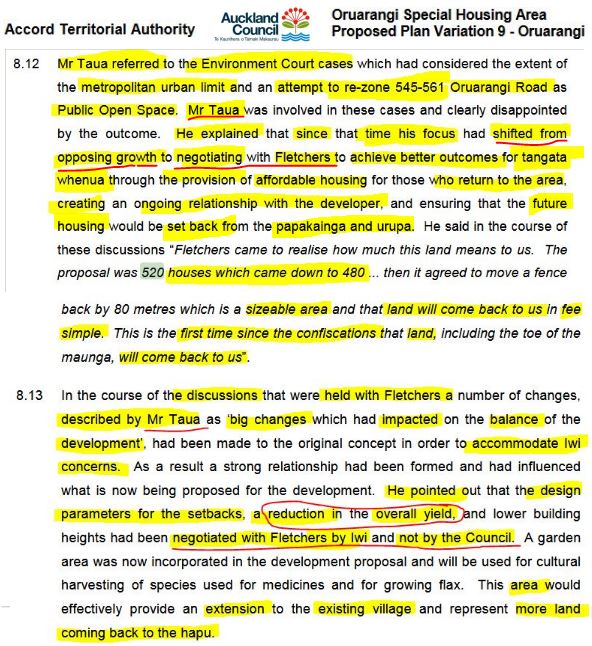
Taua’s chairmanship of Makaurau Marae Māori Trust (2013-2019) is also questionable given his ongoing relationship with Fletcher Building because he has clearly given the construction consortium the impression that Te Kawerau ā Maki Iwi represents the mana whenua of Ihumātao. As late as May 3 and May 7 2019, The New Zealand Herald’s property reporter Anna Gibson quoted Fletcher Residential CEO, Steve Evans, claiming just that and more. In an article headlined, “Ihumātao protesters block Auckland road, vow to stop Fletcher developing 480 new homes”, Gibson quoted the Fletcher Residential CEO, who bragged about a buffer zone being returned to Te Kawerau ā Maki, because they were the only tribe mentioned. Evans PR statement said:
“Returning this land is important to us, and to Te Kawarau a Maki – it will be the first time in a 150 years that their name will be back on the land. We understand that this is the first agreement of its sort between an iwi and a corporate for the return of the land.”
It appears Mr Taua’s presentations about his tribe’s alleged ancestral connections to the whenua at Ihumātao also extend to other pertinent Pākehā parties in the land transaction, such as the Wallace-Blackwell family that own Gavin H Wallace Limited, the company that held private title to the disputed ‘Wallace Block’. In a news article – “Ihumātao protest: Former landowner the Wallace family speaks out against stand-off” – Fairfax‘s Stuff correspondents, Harrison Christian and John Anthony, anonymously quoted the only male director of Gavin H Wallace Limited, John Wallace Blackwell of Dargaville, with a 22.22% stake in the company stated:
“[Te Kawerau a Maki kaumatua Te Warena] Taua, the head of the village, came up with an agreement, a compromise, and got a very good deal, and these other people have come out and put his decision and the housing under risk. It’d be a shame if they lost out.”This [protest] group that’s got going, the information they use is what I’d call very unreliable.
About 80 per cent of that land is ploughable and has all been ploughed and worked and cropped. Māori used to grow wheat to supply the Auckland market in that area. They wouldn’t have done that if it was a burial ground. ”
Soul Cousins: One of ‘the six cousins’, Haki Wilson [centre with his two boys] has explored two of three three known caves on the Ōruarangi Block. Fletcher Building’s expanded buffer zone supposedly would not damage the ancient volcanic burial caves.
Not only did John Wallace Blackwell not know much about what ‘the six cousins’ knew. He either believed that Mr Taua was “the head of the village” at Ihumātao or pretended to so believe, playing along in a game of contrived ignorance that included using the news media as a transmission vector to propagate public confusion, division and conquest.

Following John Wallace Blackwell’s ‘expert’ opinion, Fairfax‘s Stuff correspondents, Harrison Christian and John Anthony, added their own commentary, stating “there were burial caves on the site and the man confirmed his mother found human bones in one of the caves” when she was a little girl.
The Wallace-Blackwell Family’s role in this dispute has been thoroughly disingenuous. The grand-daughter of Gavin Struthers Wallace (original purchaser of the confiscated land), Aisla Blackwell, told Listener journalist Geoff Chapple in 2016 that after the Environment Court hearing of 2012, the Auckland Council raised their offer to $6.5 million. Blackwell stated,
“We offered it to the Council, but the price was not satisfactory. They offered around $5 million, and after the [2012 Environment] Court case they offered $6.5 million. The Council never got beyond that. I’d have preferred the Council if they gave us a good price, but they wouldn’t, and we’d already lost the best part of the farm.
“We sold the first 52 acres [21ha] to help the Otuataua Stonefields Reserve, for just over $1 million, I think, in the 1990s, so that was our contribution to the public good. It was all a matter of offering us enough money for this remaining section – that’s all there is to it. I think Fletchers are good. I think they’ve got great plans.”
Ailsa Blackwell stated in 2016 the land sale was all about getting enough money for the remaining land the Wallace-Blackwell family owned. This stance appeared to be consistent with the one they advanced in the Environment Court in 2012, although they claimed any development could be done sensitively on the senstive land. The behind the scenes means with which the Wallace-Blackwell Family dealt with Fletcher Building, however, to reach a conditional sal agreement with consultation with Makaurau Marae, appears to contravene assertiosn that that development plans were ‘senstive’. The murkiness with which Wallace-Blackwell Family reached deal with Fletcher Building, and then the construction company’s subsequent dealings with Te Warena Taua, actually undermined Mr Taua’s prior stance that the land at Ōruarangi was wāhi tapu and should be preserved in pristine condition. Gavin H Wallace Ltd’s manipulative, paternalistic argument in the 2012 Environemnt Court case was that the Māori and heritage values might be protected if the land were excluded from the Metropolitan Urban Limit, but it wouldn’t provide for the economic needs and well-being of the owners. In other words, Gavin H Wallace Ltd’s position in the Neo-Colonial Crown’s Environment Court was this: as the ancestors of settler Gavin S. Wallace – who acquired the confiscated land in 1866 at an auction held by the Colonial Crown’s Waste Lands Office – their alleged claims to “economic needs and well-being” outweighed the customary rights of tangata whenua of Ihumātao. Because the Environment Court ignored failed to observe the 1835 Declaration of Indepedence and te reo Māori language version of the Te Titiri o Waitangi, the customary rights of tangata whenua at Ihumātao were run roughshold over.
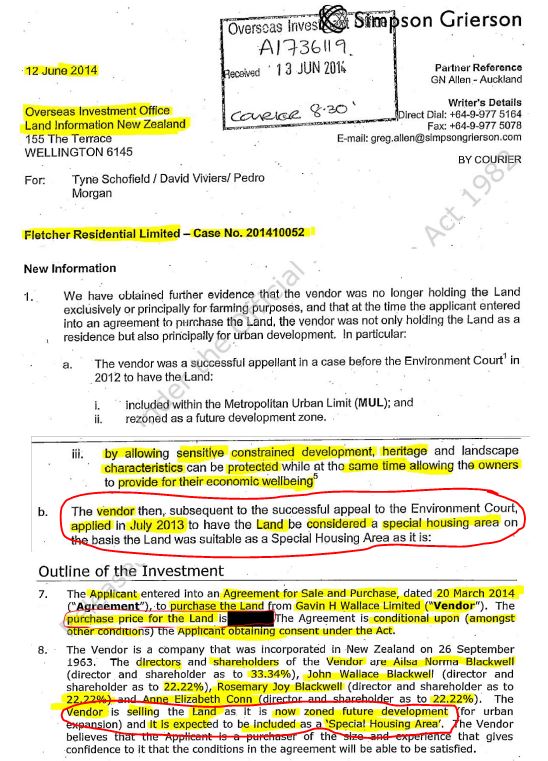
Mr Taua’s ‘about-face’ after losing in the Environment Court requires closer scrutiny because his impact in spreading the impression that Te Kawerau ā Maki is the local iwi at Ihumātao has been pervasive. This fraudulent posture can be seen in another article “The Detail: Why Ihumātao has opened up rifts among Māori – How Ihumātao went from a precious garden to a battleground” that was reproduced by Fairfax‘s Stuff after it was published by Newsroom on July 30 2019 in association with RNZ. In its regular feature The Detail, Newsroom‘s Ihumātao explainer incorrectly positioned “Te Kawerau ā Maki [as] the local iwi.”
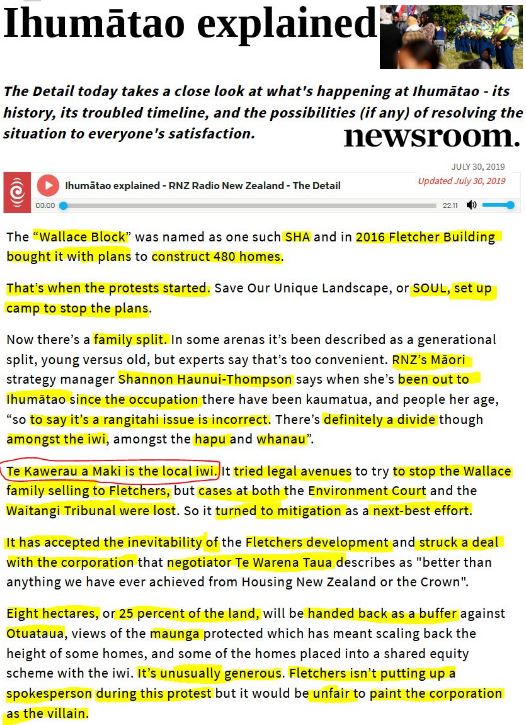
In Fairfax‘s Stuff story “The Detail: Why Ihumātao has opened up rifts among Māori” – Alexia Russell not only repeated the error that “Te Kawerau ā Maki is the local iwi.”
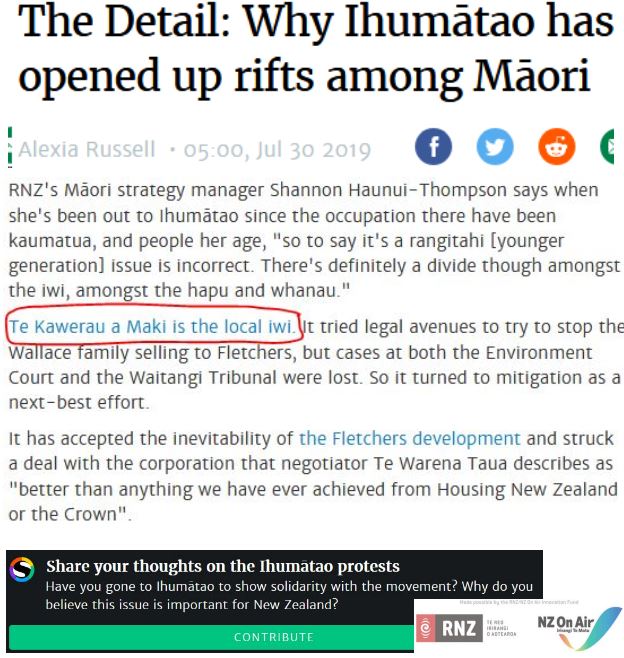
Stuff‘s reporter Alexia Russell also added a link to the crucially inaccurate claim that “Te Kawerau ā Maki is the local iwi” of Ihumātao. It turns out this link returns the news audience to an earlier Stuff report that gazetted the Auckland Council’s finance and performance committee vote in June 2018 to gift Te Kawerau ā Maki land at Te Henga/Bethells Beach, to build a marae and papakāinga housing. The story even quoted Te Kawerau ā Maki Iwi Authority chief executive Edward Ashby who said, “This is essentially the very heart of Te Kawerau ā Maki so we want to do it once and we want to do it well.” In other words, Ashby was really saying – Te Kawerau ā Maki ties are in the Waitakere Ranges, its foothills and valleys and the rivers, as well as the West Coast by the Waitakere Forest. Which is ironic, because Ashby changed his tune when it came to opposing the petition of Ihumātao kuia, Betty King, Pania Newton, and SOUL later in 2018 in the Environment Court – where they sought to have Heritage New Zealand’s decision to approve Fletcher Building’s archaeological application overturned. Brazenly, Ashby positioned Te Kawerau ā Maki as the local iwi of Ihumātao, inoculated himself by acknowledging that there might other iwi who are tāngata whenua in Ihumātao, because the Tāmaki Region is a popular place. The Environment Court Judge D A Fitzpatrick quickly moved on, in keeping with Inoculation Rituals, which is a public relations tactic where the weakness of the matter at hand is acknowledged, then quickly brushed aside. The intention is that the audience thinks nothing more of it, satisfied that there is nothing under-handed to see, as the documentary The Hollow Men showed.
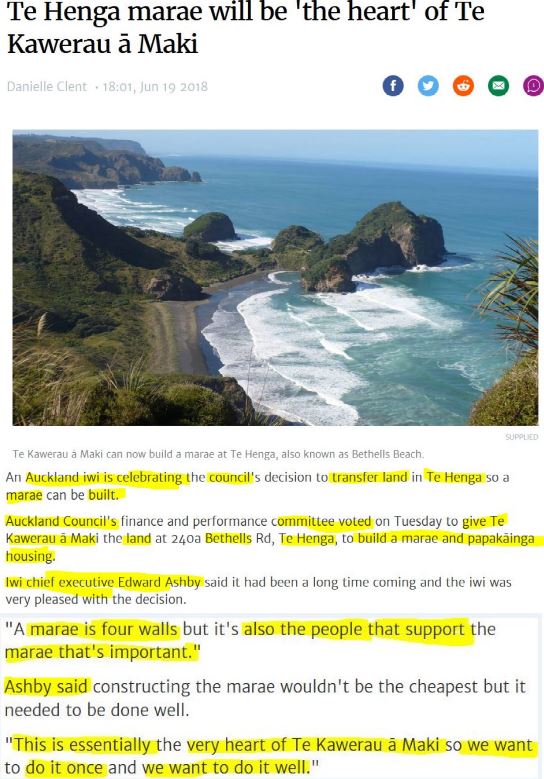
Worse, Te Kawerau ā Maki Iwi Authority chief executive Edward Ashby would later submit in the Environment Court a cultural impact that he prepared in 2015 that set out the his tribe’s connections with the Wallace Block at Ōruarangi in Ihumātao. In a May 2016 Housing Accord Territorial Authority hearing, Fletcher Building admitted its Cultural Impacts Assessments were written for them by Te Ākitai Waiohua and the Te Kawerau Iwi Authority and Makaurau Marae Māori Trust. Indeed, Te Warena Taua also wrote a Cultural Impact Assessment for Fletcher Building. These occurrences should have raised red flag about conflicts of interest, followed a finding in a 2015 Council consent hearing that Fletcher Building’s proposal included paying an undisclosed sum to the Makaurau Marae Māori Trust. Yet, Fletcher Building’s housing development proposal proceeded without any deep investigation into whether or not the cultural impact assessment work meant there were payments attached that might have doubled as cash bribes, and whether the Makaurau Marae Māori Trust also received bribe money. Furthermore, Environment Court Judge D A Fitzpatrick recounts Ashby’s cultural impact assessment stating it noted that in face of a development that Te Kawerau ā Maki Iwi Authority and Settlement Trust had “little legal ability to stop” the developomet, the iwi “decided to work with the landowner.” With such fictions throughout, Environment Court Judge Fitzpatrick’s institutionally racist ‘Decision’ meant that Betty King, Pania Netwon and SOUL lost their appeal to have Heritage New Zealand’s archaeological approval of 2017 overturned.
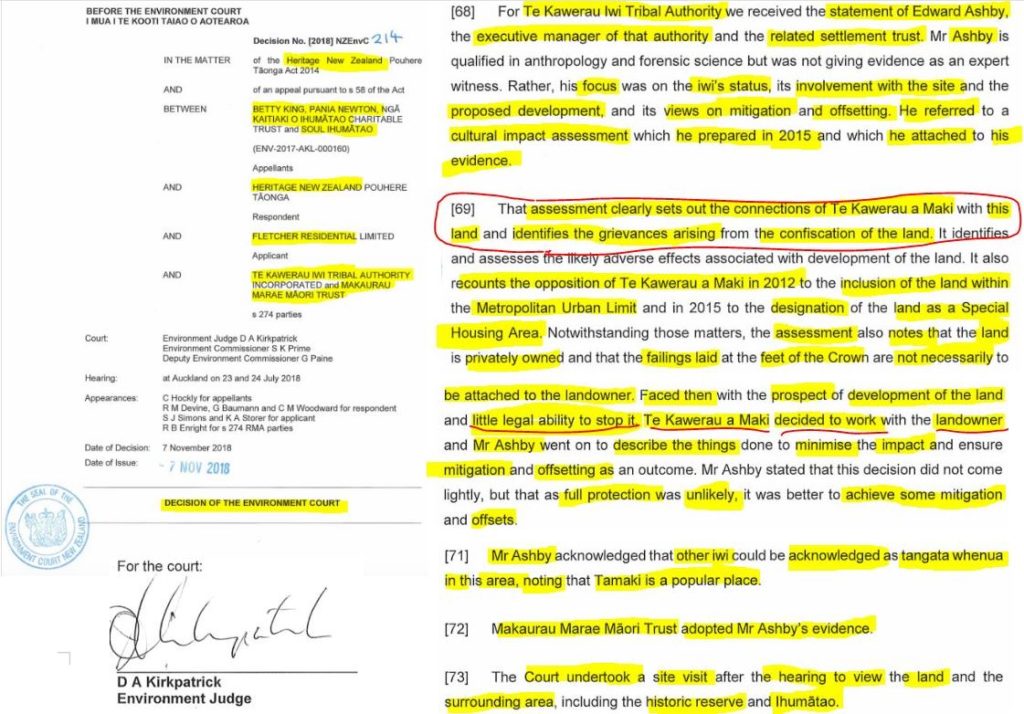
The Establishment Media, educated by the Pākehā-dominated Crown curriculum – echoed the Crown-Council-Court sponsored cacophony of propaganda. At first, the news media followed the Prime Minister’s politely racist ‘confusion cues’, in which she framed the problem was for mana whenua to solve, thereby insinuating the Crown, the Councils and Courts were just blameless, helpless Pākehā bystanders expressing kindness – from an unseemly distance. The Ardern Coalition Government’s Māori Labour Caucus helped protect the Neo-Colonial Crown from criticism that it was practcising institutionalism racism by deploying manipulative arguments in its attempts to retake win the battle of the narrative through controlling the crisis rituals.
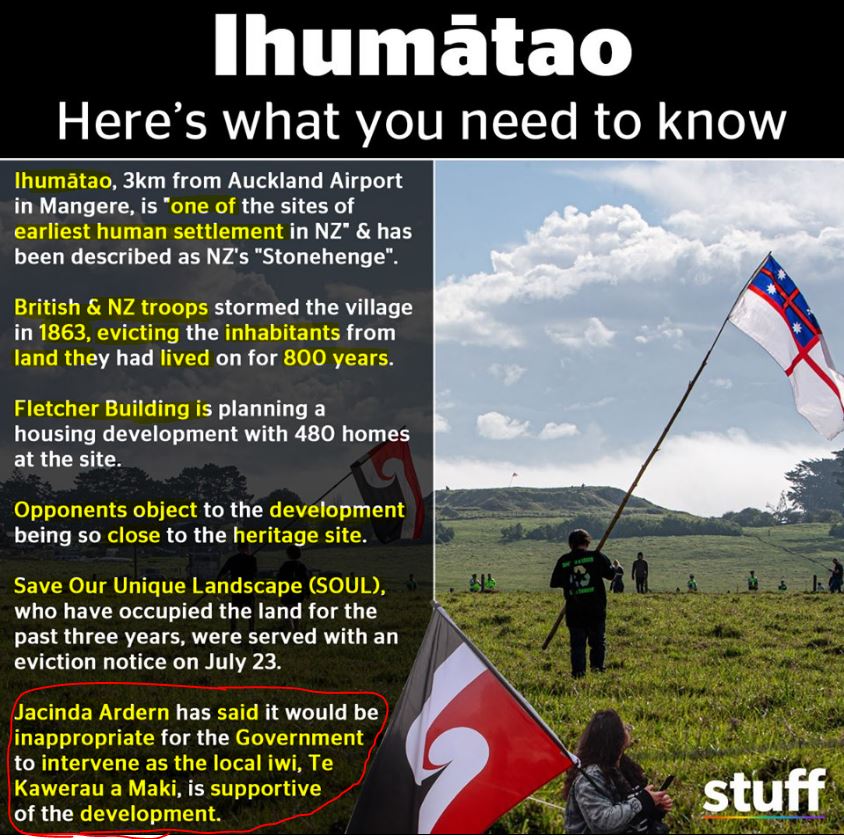
In the interviews associated with the image collage below, the country’s top lawmaker’s framing shifted daily, with new solutions offered to the problem. NZ’s PM started out saying the solution was to be found in the hands of Council and other parties involved on MaiFM. The communications graduate said the solution was to be found by mana whenua to every news outlet, repeatedly. Then, this sneaky game of Hide-the-Problem-and-Seek-the-Solution shifted to saying that the solution was to found in iwi discussing the issue with mana whenua and council and the developer, and that such a process include the rangatahi or young people occupying the land. The PM’s messaging was clearly targetted at the brainwashed news audiences, and not for those familiar with the issue. The palpable paternalism in Jacinda Ardern’s statements were unwisely amplified with dog-whisting, when she also insulted SOUL’s campaign supporters, saying, “We just ask that they be respectful, that they look after the land that they will be visiting.”

In effect, the PM’s dog-whistling echoed Auckland Mayor Phil Goff’s dog-whistling tweet, when he typed “there be will be huis soon. In the meantime please respect each other and the land.” This means they are two peas from the paternalistic pod, because it was the Auckland Council and the Crown whom approved the residential development project with fast-tracked Special Housing Area designation that would make bulldozers scraping the historically significant land inevitable – without an ahi kaa grassroots kiataki whenua warrior intervention. Especially, since Goff and Ardern both parked SOUL’s petition in a virtual Bureaucratic Avenue, with the Ancestral Whenua-Space Meter running to see if a number of signees could catch up with the hundreds of millions of dollars in profits that Monopoly Board company, Fletcher Building, would have to forgo on their way to jail – if Aotearoa/New Zealand found out the transnational construction cartels’ development project entirely depended on collusion with Council, the Courts and the Crown – as this exposé lays bare.
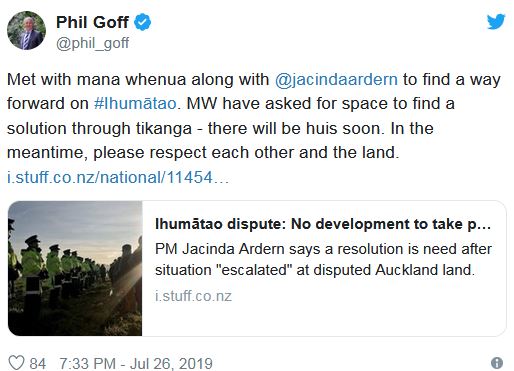
Ironically, in its Deed of Settlement of Historical Claims, Te Kawerau ā Maki Iwi did not claim to have owned any land at Ihumātao and only mentions the location twice in passing. Herald property reporter, Anna Gibson, stated that the land was not available to Te Kawerau ā Maki when the iwi negotiated its Waitangi Treaty settlement with the Crown. The insertion of this sentence, which Gibson used in her other Ihumātao stories, furthering the impression that the land in question was confiscated from Te Kawerau ā Maki Iwi in 1863, and that one of the protest group’s core voices, Qiane Matata-Sipu, was an interloping Māori wahine moaning that the land “went to a Pakeha farmer who sold it to Fletcher.” Te Kawerau ā Maki tribe’s own Waitangi Treaty Deed of Settlement states that it was not until “the first decades of the twentieth century … Te Kawerau ā Maki left their remaining lands and resettled at Ōrākei, Ihumātao and Pūkaki.” The document stated that some of the tribe’s families live at Ihumātao. The iwi also described itself as a landless, marae-less iwi, which means in tribal terms, Te Kawerau ā Maki were a homeless indigenous people. The tribe’s traditional stronghold was the Waitakere Forest, Murawai, and Te Henga/Bethells, with customary interests in parts of the upper Waitemata Harbour, Southern Kaipara, the North Shore and Mahurangi.
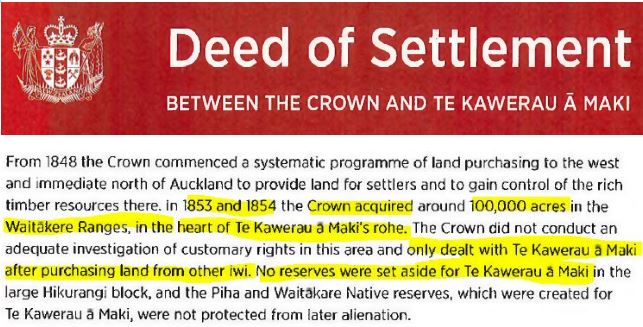
The Area of Interest [depicted in the map below] shows where Te Kawerau ā Maki exercises kaitiakitanga for the purposes of the Resource Management Act 1991, which governs how the Environment behaves or otherwise, and was agreed between Te Kawerau ā Maki and the Crown in the Deed of Settlement signed on 22 February 2014. The Deed of Settlement did not mention Ōtuataua Stonefields Historic Reserve, nor Ōruarangi at Ihumātao, and therefore made no claim to being mana whenua at Ihumātao and Makaurau Marae. Rather, the Deed Settlement includes a Māori reservation at Te Onekiritea Point in Hobsonville to build a marae and specifically claimed ancestral heritage to Te Henga/Bethells with land signposted for an historic reserve and fee simple land for Te Kawerau ā Maki to build a marae (which the Waitakere Council bought in 2009 for the iwi) – as well as registering fee simple sites at Swanson, Henderson, and Murawai.
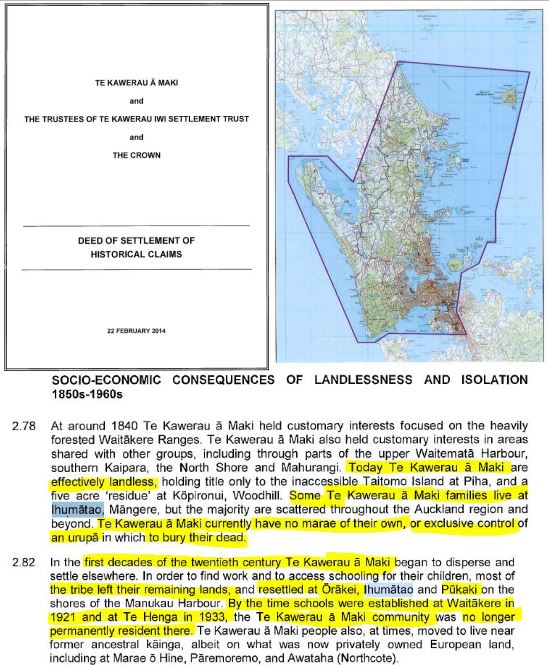
The mandated signatories to Te Kawerau ā Maki Deed of Settlement included members of Te Warena Taua’s family, while Te Warena Taua MNZM was recognized as the mandated negotiator for the Te Kawerau Iwi Tribal Authority.
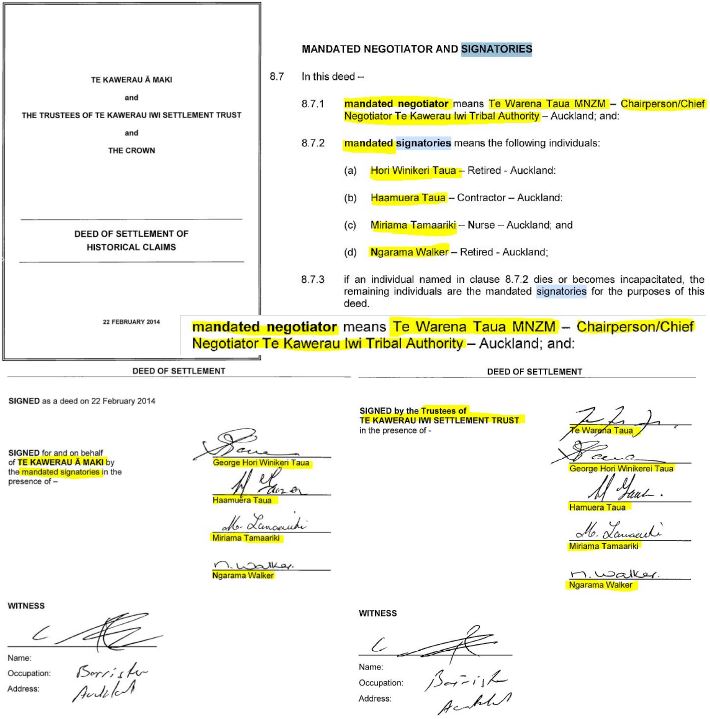
In an interview with TVNZ’s Marae programme aired in April 2019, reporter Hikurangi Jackson asked Mr Taua if he had a mandate, he replied, “I wouldn’t be doing this if I didn’t.”
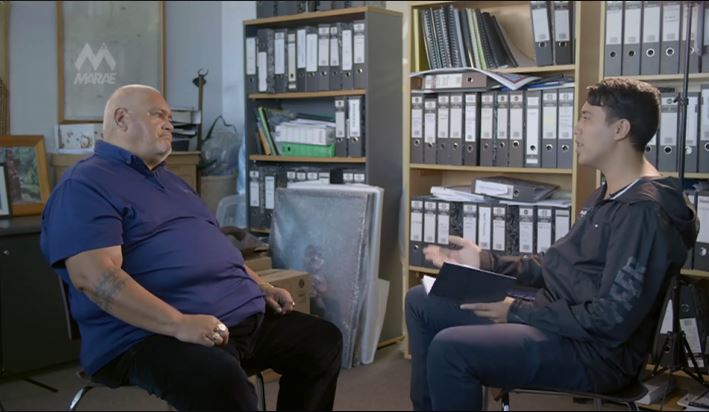
Next, Hikurangi Jackson asked, “How come we haven’t heard from any other mana whenua in the media, or your supporters, because we only ever heard from you?”
“Our people don’t go rushing to the media. It’s a Pākehā process of battering heads and stories going left, right and centre. Our people don’t like the media. Why am I talking to you today? To get our side of the story ahead. Half of Ihumātao are Te Kawerau ā Maki. My people support me. I don’t need the support of SOUL. They are not constituted. They are not mandated. SOUL as a group has no mana.”

Jackson if he had sold-out, Mr Taua retorted,
“What does that mean – sell-out? I bought in. I’ve got something for our people. Is that selling out? I’ve got a quarter of the land back to our people. It’s going to come back. Quarter of the land coming back to our people. That’s not sell-out. I’ve negotiated hard for this. Huge koha that will come back to our marae.”
It turns out, a company called Tahi Enterprises, whose sole director, Dianne Lee, says entered into a joint venture deal with Te Warena Taua believing he had the authority of Te Kawerau ā Maki to borrow from Tahi to assist with their Treaty settlement claim. Lee says in 2007 she went on a tiki tour with Mr Taua around Hobsonville, Whenuapai and Riverhead, and claims this tiki tour was instrumental in convincing her that Mr Taua was seeking a business partner to help his iwi develop the assets he hoped they would gain back off the Crown in a Treaty settlement. Te Karere journalist Te Rina Kowhai reported Friday 6 September that Lee said once Te Kawerau ā Maki settled with the Crown, Taua severed communication with Tahi Enterprises and Lee has since expended almost half a million dollars in legal fees seeking redress. Friday Septmeber 6th did not go as well as Mr Taua planned, since he was intending to have the three-dissenting committee members of the Makaurau Marae Māori Trust ejected in the Auckland High Court since they had dared to disobey his authority as Committee Chairman. The case was postponed at short notice.
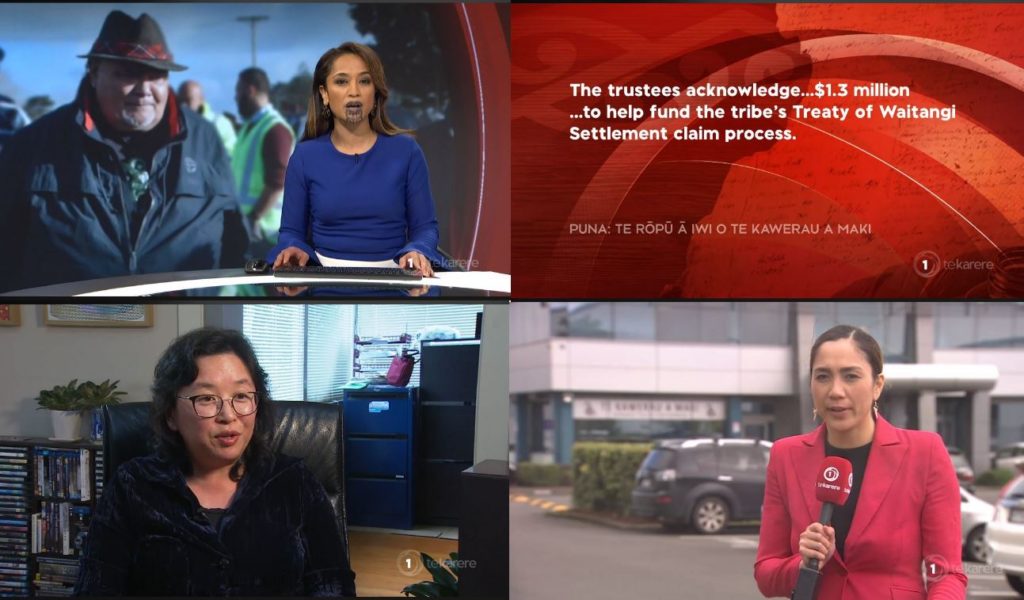
The Māori Land Court specifies the legal expectations of trustees, committee members and management of Māori incorporations, which include marae trusts, tribal authorities and iwi settlement trusts. The Māori Land Court website emphasizes:
“Your key duty is to maximise the assets of a trust and minimise its liabilities – or – to hold onto and grown the value of the existing land or shares without incurring significant costs.”

Virtually while Mr Taua’s dealings with Tahi Enterprises were being laid bare in the Auckland High Court pre-trial proceedings — as the next section shows — TVNZ‘s Marae were interviewing Te Warena Taua, Qiane Matata-Sipu and Pania Newton in April 2019 about the Fletcher development dispute at Ihumātao.
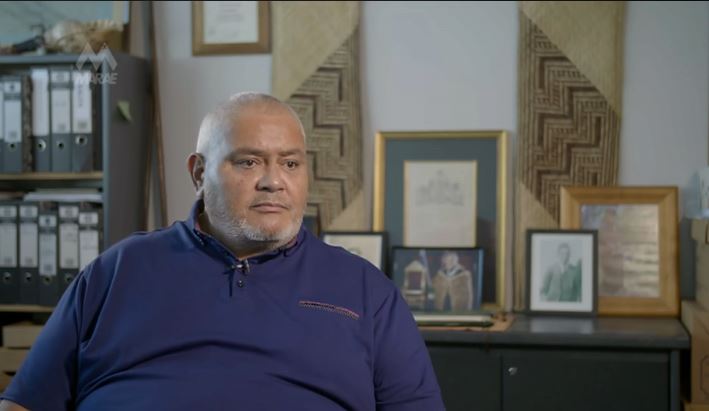
“I’m not going to let an outsider, like Pania (Newton) who I don’t even know come into our village and cause disruption by getting a handful of people and then numerous numbers of other people from the outside into our village. At the end of the day, they [SOUL] do not speak for the whole village. Do I speak for the whole village? No. Only for those who’d like me to speak for them. I’m mandated, they are not.”
Marae cut to Pania Newton sitting with Qiane Matata-Sipu. Core SOUL founder of Ngati Mahuta, Waikato-Tainui and Ngāpuhi – Pania Newton, stated:
“For me, him and I are essentially fighting for the same thing, which is to do right by our people. So I asked my uncle (Te Warena Taua) – let us walk along side you, let us support you. Teach us from all of your experiences over the many years that you’ve fought against the Airport and Council developments.”
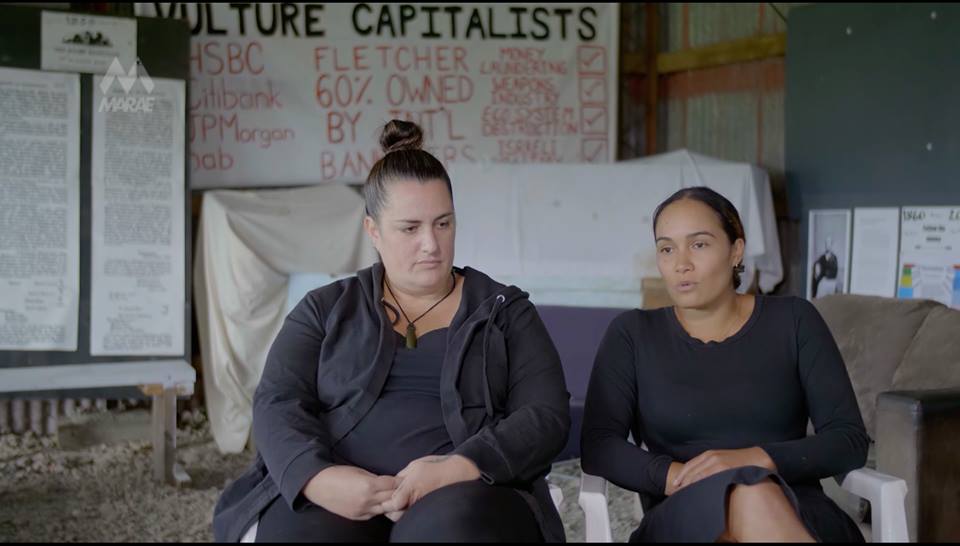
Core SOUL founder of Te Waiōhua and Waikato-Tainui, Qiane Matata-Sipu had the last word, stating:
“Other iwi who might whakapapa here may want to agree to the development because it might house certain members of whanau. But they got other whenua they can go back to when this is gone. We’ve got nothing after this. This is it.”
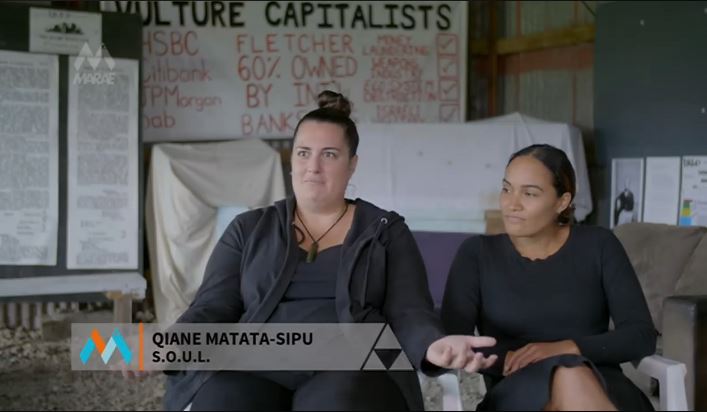
Audaciously, Fletcher Building challenged Pania Newton’s “standing” in the Environment Court, as the Court’s November 2018 report records – without cringing with embarrassment. Because Pania Newton is one of ‘the six cousins’ — whose stomping ground as tamariki is the papakāinga at Ihumātao, the Environment Court should have known by late 2018 that Newton’s pedigree, since it was reported, for instance in October 2015, that she and her cousins grew up at Ihumātao village “where around 80 families trace their descent to Te Waiohua and Te Ahiwaru of Tainui waka.” That report “Sacrifices but no reward” was filed by multi-award winning journalist Wena Harawira (who started out as a seventeen year-old under the wing of none other than multi-season One Network News anchor, Judy Bailey [1987-2003], of Pākehā-household-name-fame). Moreover, at the very place of the occupation, Puketapapa, one of Newton’s tupuna or ancestors, lived – as she told Vice Magazine in mid-2017, in a story “Taking the Fight for Ihumātao All the Way to the United Nations”. This tupuna is no less a figure than Te Aho o te Rangi Wharepu, son of Pōtatau Te Wherowhero — the first Māori King, who was elected to the position at a ‘monster Maori gathering’ Ihumātao in mid-1857. Chief Te Wherowhero, who was the only chief at the time with the necessary mana to establish a Kingship — reluctantly agreed — and was elected with a clear mandate: place a tapu, or sacredly tabu decree, over Māori lands to halt further sales to the Colonial Crown, Pākehā settlers and colonization companies.
To put ‘the six cousins’ in the correct context of the campaign to halt the destruction of Puketapapa, or the Ōruarangi Block, they are the ahi kā kaitiaki, or whenua guardians, who have led the re-occupation of the land following a Makaurau Marae hui in February 2015, with a core campaign crew of 50, to keep the home fires burning. Newton also told Vice Magazine in mid-2017 that her whakapapa extends back 28 generations to her tupuna, Hape, who evidently beat the Tainui Waka to Aotearoa/New Zealand in 1300 by riding a stingray that was conjured for him by Tangaroa, god of the sea. Evidently, Tangaroa answered his prayer after his iwi had left without him because he had clubbed feet, as Qiane Matata-Sipu told New Zealand Geographic. Upon arrival, Hape planted a tree at the four ‘the corners’ of Ihumātao, to show his iwi he was the man who didn’t need a wooden waka to travel overseas (knowing they would land there after they crossed through the portage at Ōtāhuhu isthmus between the Waitematā and Manukau harbours). Legend has it that Hape walked with clubbed feet to a ridge on Maungawhau [Mt Eden], and saw the Tainui Waka coming into the Waitematā Harbour and so he performed a chanted welcoming summons, or karanga. (The ridge was called Karanga-ā-Hape after which Karangahape Road, located at the top end of the Auckland CBD, was named). With an ancestral heritage of the first Māori King, Pōtatau Te Wherowhero, as well as the Tainui tohunga dude whose job it was to bless the Tainui Waka before its epic voyage to Aotearoa, and who was clearly gifted with spiritual Tohunga Powers to direct dial the god of the sea — if not other Atua — you have to ask: what was Fletchers thinking – or reading or consulting?
Therefore, Fletcher Building’s dismissive attitude toward Newton and SOUL was a politely racist way of saying that the transnational bank-owned construction cartel does not respect those Māori who oppose their profit-autistic, collusion-ridden business model — by directing sunlight on their ‘Formica Maori’ finish to pass the political hygiene tests of various institutionally racist ‘public’ governance authorities, whom collude to get a development over the line.
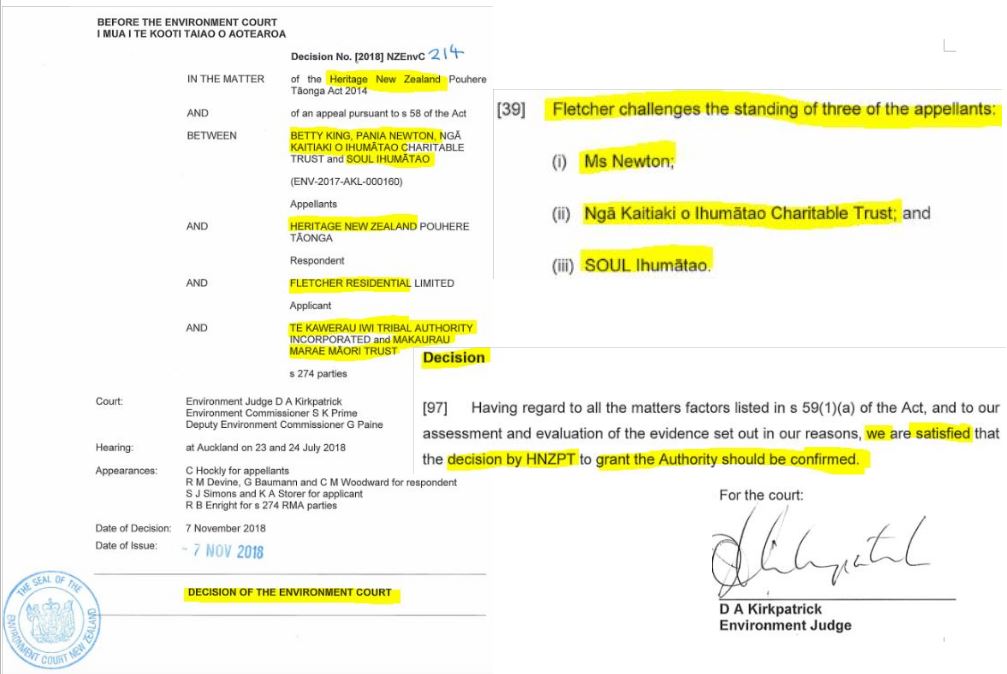
Dr Rawiri Taonui states the dispute at Ihumātao has to do with, “the preoccupation of the Auckland Council, the courts and statutory bodies on preserving Māori culture as an icon of the past rather than restoring the living relationship between Māori and their whenua”. He also notes that Crown legislation, such as the Resource Management Act, which excludes considering remedies for historical incursions into Māori territory belie endemic institutional racism.

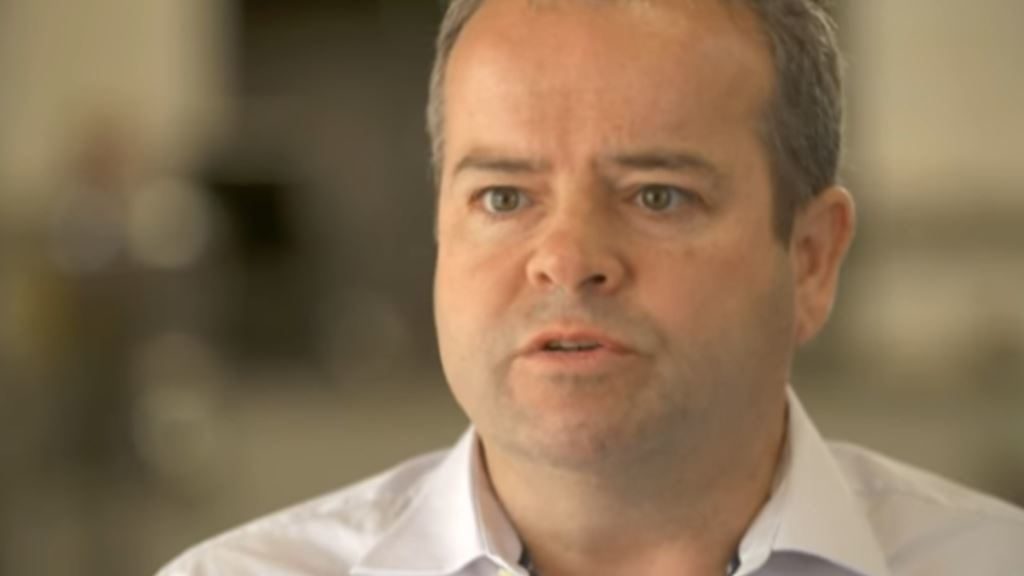
Sanitized History: Fletcher Building’s website brags about the company’s formative years, but neglects to mention that once Fletcher Challenge was spun-off in 2000, its construction industry incarnation became majority owned by three transnational banks. Unfazed by SOUL – until the groundswell support from July 23 – Fletcher Building’s Residential CEO Steve Evans had frequently claimed for the first time in 150 years that the local iwi of Ihumātao, which he stated is Te Kawerau ā Maki – will be returning to the land as a result of the housing project.
The Overseas Investment Office would appear to be an exquisite embodiment of institutional racism. The Otago Daily Times report “480 homes planned for Māori burial ground” stated the Fletcher Building application to the Overseas Investment Office (OIO), “shows that it plans to vest almost half the land (16.2ha) in Auckland Council for ‘roads, reserves, walkways and other public amenities”, including an area to be added to the historic reserve.” These are standard requirements for developments, including buffer zones between developments and reserves, yet Fairfax’s Otago Daily Times report made it seem like Fletcher Building was being generous, while the Overseas Investment Office’s investigation of consultation with iwi and hapū was clearly remiss. Fletcher Building and Te Warena Taua have made much of the eight-hectare buffer zone, which will be a wetland. Fletcher Residential CEO Steven Evans has bragged it is a great win for iwi because it means for the first time that a piece of land has come back to Māori from a private developer – as noted above. Conspicuously, this application to the OIO, the Otago Daily Times said, was required to approve the deal because 56 per cent of the company’s shares are foreign-owned. But, like so many news reports gazetted by the Establishment Media, the Otago Daily Times did not name who exactly the overseas owners of Fletcher Building consortium are – despite SOUL brandishing a board naming the transnational banks that hold a controlling interest in the construction cartel at protests and behind them in interviews at the Kaitaiki Village in the occupied ‘once was a future development zone’.
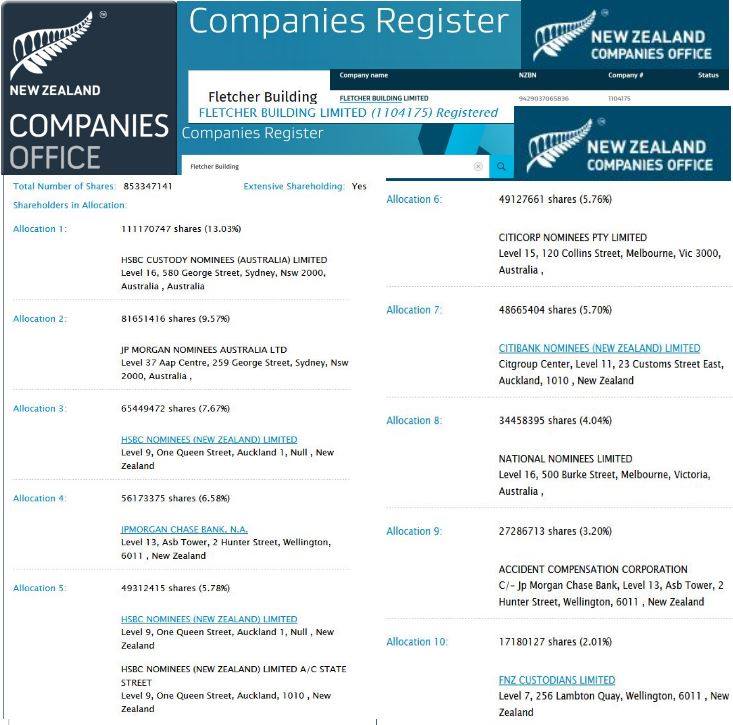
Transnational Construction Cartel: Three transnational banks own 54.09% of the Fletcher Building Ltd consortium: HSBC 26.48%; JP Morgan Chase 16.15%; CitiBank 11.46%.
Three transnational banks own 54.09% of the Fletcher Building consortium, which transmogrified out of the Fletcher Challenge. These are HSBC which owns 26.48% of Fletcher shares, while JP Morgan Chase Bank holds a 16.15% stake and CitiBank controls 11.46% in stocks. A further 2% is owned by asset management company, FNZ Custodians, which like HSBC, JP Morgan and CitiBank, owns stocks in a company called Rubicon, which was set up in 2001 to facilitate the takeover Fletcher Challenge Energy (which grew out of the state-owned PetroCorp) by Shell and Apache Corporation – as business analyst Brian Gaynor wrote in “Selling all our assets makes New Zealanders ‘serfs in our own country’”. Hugh Fletcher of the Fletcher Dynasty was a director of Rubicon (up until the end of September 2019), whose major shareholdings are like a mirror image of Fletcher Building. In other words, the Environment Court Judge D. A. Kirkpatrick did not recuse Fletcher Building’s Counsel for questioning Pania Newton’s standing and the entities ‘the six cousins’ have created to fight the Fletcher development – despite it being an indigenous person’s right to withhold evidence of whakapapa. It is good enough that people of the community accept their indigenous bone fides – as co-petitioner, Betty King, clearly did and whose standing as a well-respected kuia was regarded by all as above reproach. Nor did the Environment Court judge order evidence of Fletcher Building’s whakapapa.

To get this Ōruarangi development at Ihumātao through a significant regulatory hoop, a joint waiver was required by two Key Ministry Crown Ministers in early September 2014 to over-ride breaches to the Overseas Investment Act of 2005. The Wallace-Blackwell Family company, Gavin H Wallace Limited, owner of ‘the Wallace Block’ – as the highly contested land at Ihumātao is locally known – failed to advertise the farm land on the open market prior to sale to the transnational construction company, Fletcher Building.
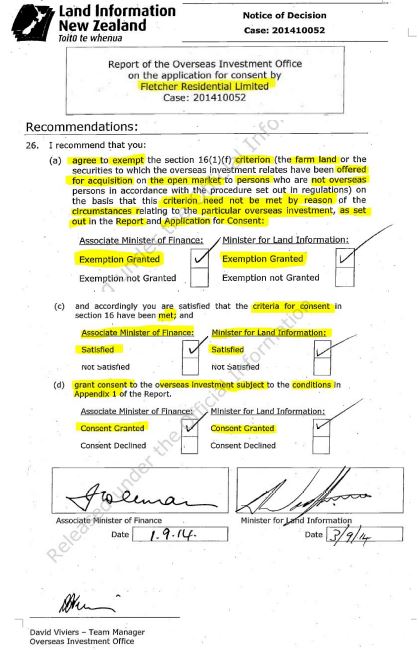
It is, therefore, ironic that when the disputed land at Ihumātao was originally lost in 1863-1866 period in the midst of what was, in fact, the New Zealand Masonic Revolutionary War – the land was far better advertised. In July and August of 2014, when it was advertised in a couple of local newspapers and on TradeMe, the adverts failed to state any identifying location numbers such as the street, lot or property title numbers.
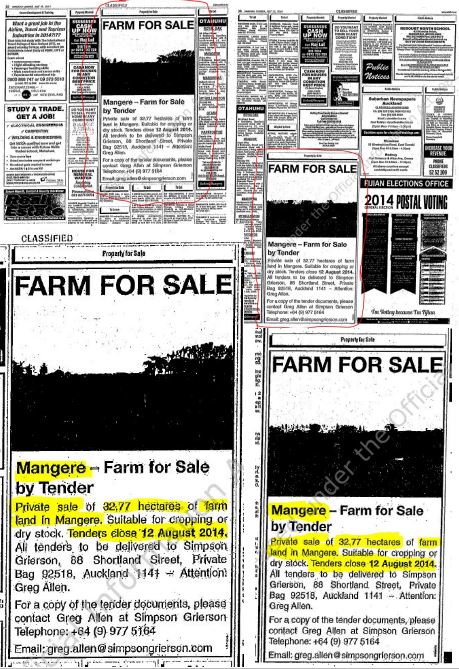
Whereas, in 1866 – following Freemason Governor Bro. George Grey’s eviction proclamation of July 9th 1863, and a confiscation Order in Council of May 16th 1865, as well as Native Compensation Court proceedings of March to May 1866 that callously decided the lands at Ihumātao were forfeited because of “defection” to the so-called rebellion by “certain relatives and clansmen” of two great families – there were several Gazette Notices to auction the lands that stated the lot numbers, as The Snoopman showed in “Deep History of Ihumātao: The Methodist Connection”.
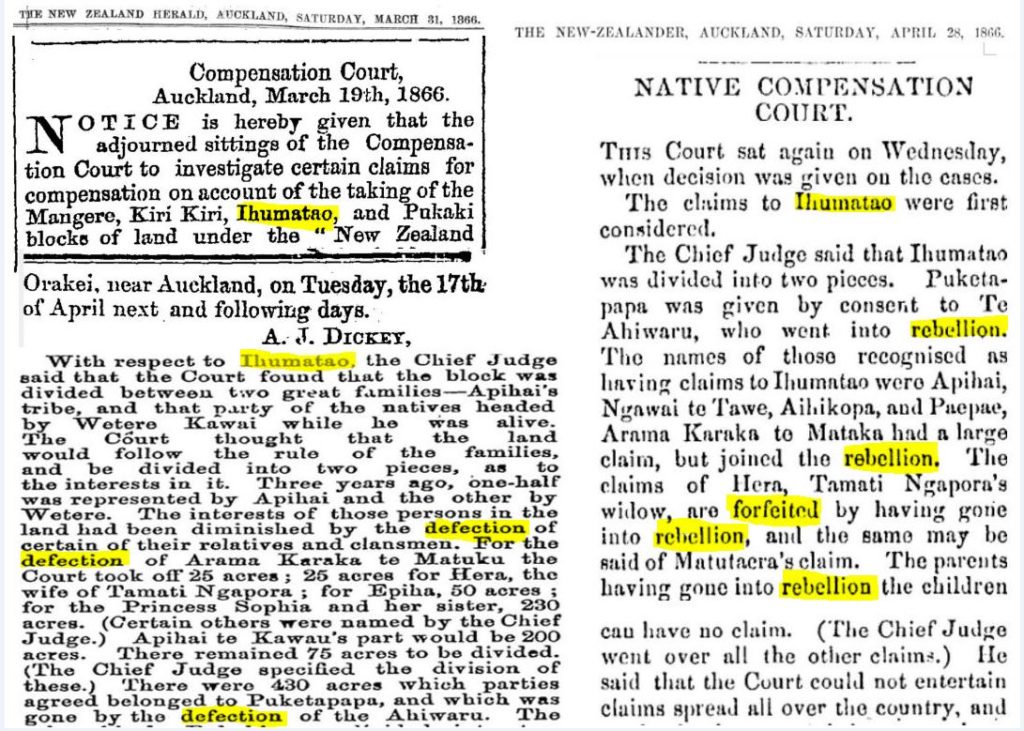
The parcels of fertile land at Ihumātao, designated as Lot 13 (175) and 14 (176), were swiftly bought by Gavin Struthers Wallace at an auction held by the Waste Lands Office on July 17th 1866.
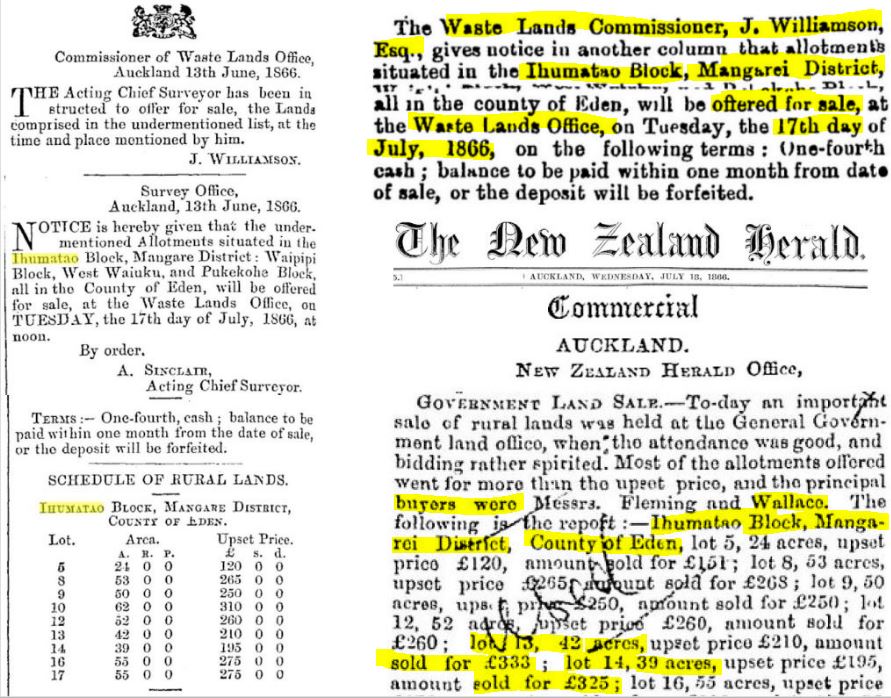
This sale – which was sealed as a Crown Grant on 28th December of 1867 – bears the signature of no less a figure that the Governor of the Colony and Commander-in-Chief of the Armed Forces, Freemason Bro. George Grey (as shown above). Ironically, Bro. Grey signed this land grant a month after he himself received notice of his recall as Governor of the colony to return to London.
You would think Heritage New Zealand would live up to its name and protect a site with burial caves in volcanic rock under fields of scattered scoria stone that were once part of a continuous landscape farmed, foraged and ranged over by Māori more or less continuously for 800 years – from development by a transnational bank-owned construction cartel bearing the family name of an Auckland Councillor. Especially, since the continuous landscape – before it was separated by No. 8 wire fencing – provided food for the Auckland Market produced by Māori.
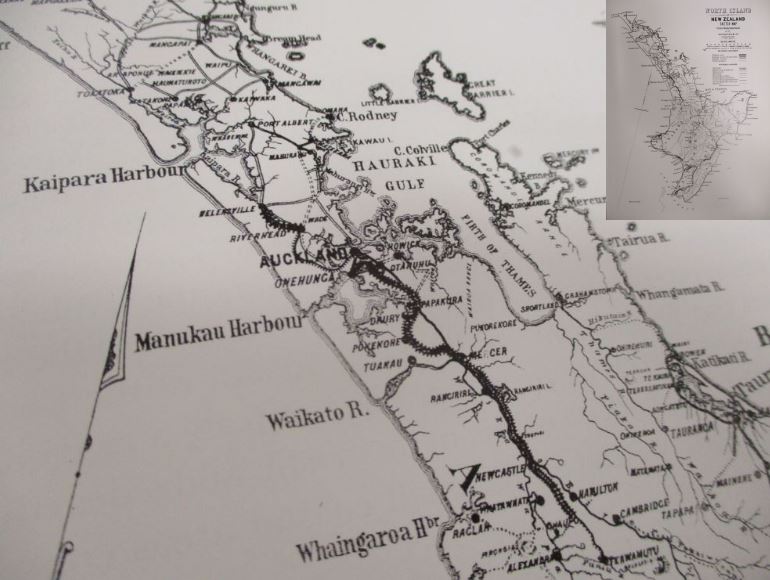
Moreover, the same Māori – give or take a few who succumbed to mortality – who also built with their ‘free labour’, the Ihumātao Wesleyan Methodist Mission Station when it was established in 1846 – as The Snoopman reported in Deep History of Ihumātao: The Methodist Connection. Furthermore, Ihumātao is not only the place where the first Māori King, Chief Te Wherowhero Pōtatau I was elected in mid-1857. In fact, two of five meetings that established the Kiingitanga occurred at Ihumātao between 1856 and 1858, which you would think would reinforce the mana of Ngāti Te Ahiwaru and Ngāti Māhuta. Ihumātao is also the second landing place of the Tainui waka after it crossed the portage at Ōtāhuhu in 1300AD.
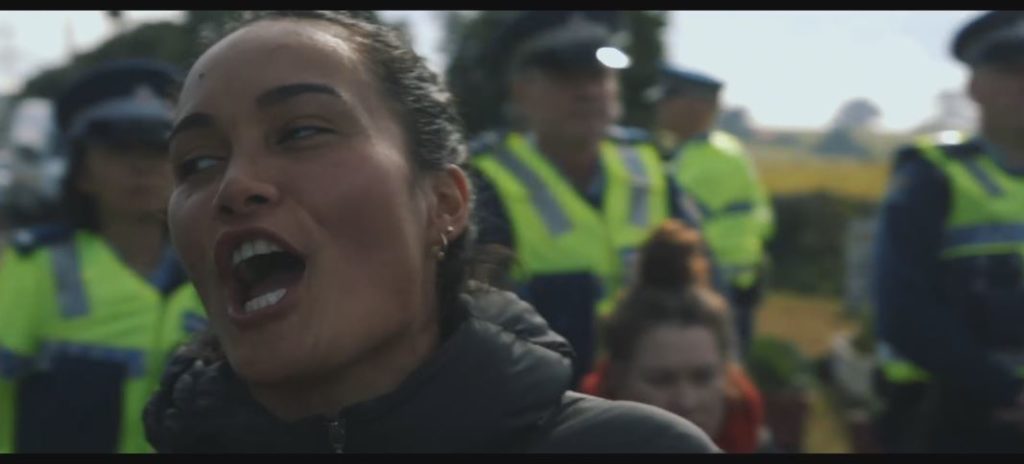
Tahi Enterprises vs Te Warena Taua
In his dealings with Tahi Enterprises, Taua’s judgment is also questionable. According to the Auckland High Court, the recipient of the New Zealand Order of Merit for his services to Māori and conservation in the Queen’s Birthday Honours List of 2004, entered into two agreements with Tahi in 2007 and 2008 to borrow up to $2 million to assist with the iwi’s Treaty claims while in return, Tahi would receive a 35% stake in all Te Kawerau enterprises in perpetuity and 4% of assets.
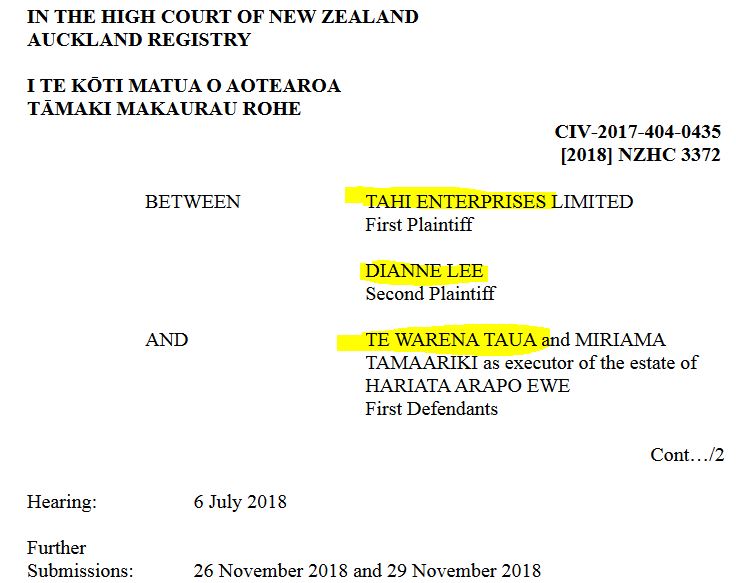
In the ongoing pre-trial proceedings at the Auckland High Court between Tahi Enterprises and Te Kawerau ā Maki, it appears Dianne Lee, the sole director of Tahi, made payments totalling $1.3m to Te Kawerau ā Maki Tribal Authority – as per two agreements of 2007/2008 to loan up to $2 million to assist with the iwi’s work to reach a Waitangi Treaty settlement with the Crown.

Given the current rift at Makaurau Marae, it is relevant to note Te Kawerau ā Maki Tribal Authority trustees are alleging there were not and are not a legal entity and that members such as Te Warena Taua have no authority to contract, incur liabilities and make agreements on behalf of the iwi. Te Kawerau ā Maki Tribal Authority was established by Taua on July 13th 2008.

The judge, Justice Smith, on December 18 2018 ordered Te Kawerau ā Maki Tribal Authority trustees to make their register of their 400 members available for a viewing to Tahi Enterprises, who have to prove that the iwi members either consented or did not consent to the agreements that Te Warena Taua (and two others) made, evidentially claiming they had authority to make on their behalf.
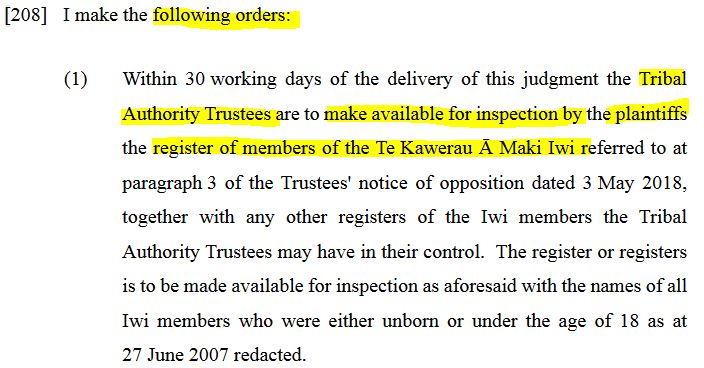
This would appear to have bearing on Te Warena Taua’s public statements about having authority as Te Kawerau ā Maki Tribal Authority Chairman to make decisions for the iwi in his relationship with Fletcher Building and its development project at Ihumātao. He also appears to have led Fletcher Building to believe that Te Kawerau ā Maki have the best mana whenua pedigree status at Ihumātao , or Fletcher CEO Steve Evans is playing along with the Crown, the Council and the Courts’ collective contrived ignorance. Mr Taua actively excluded Te Ahiwaru Waiohua and Ngati Mahuta – whom have longer historical links to Ihumātao – when he negtoiated with Fletcher Building to mitigate the impacts of the development, rather than stop it. Therefore, this Tahi vs Taua ruling by the Auckland High Court justice appears to have significant bearing on the land dispute at Ihumātao. In the case of Tahi Enterprises vs Te Warena Taua and Te Kawerau ā Maki, Tahi have to establish whether or not the iwi members consented to the deal director Dianne Lee made with Mr Taua, and when and by what means did they convey consent, or decline consent, to Mr Taua and his associates.
In other words – and in regard to the Ihumātao land dispute – at no time has Fletcher Building been held to the same test to prove that it actually had the consent of iwi/hapū at Ihumātao. Instead, Fletcher Building’s communication to Auckland Council in November 2013 – which followed the ascent of the Special Housing Area Act on October 13th 2013 – that it intended to develop at Ōruarangi, was designed to cue the Council’s Housing Projects Office to get the ball rolling so that ‘the Wallace Block’ could be designated as a Special Housing Area to fast-track its processing and avoid – it convinced itself – having to gain open, free consent through consultation with iwi/hapū at Ihumātao, where there is a physical marae.
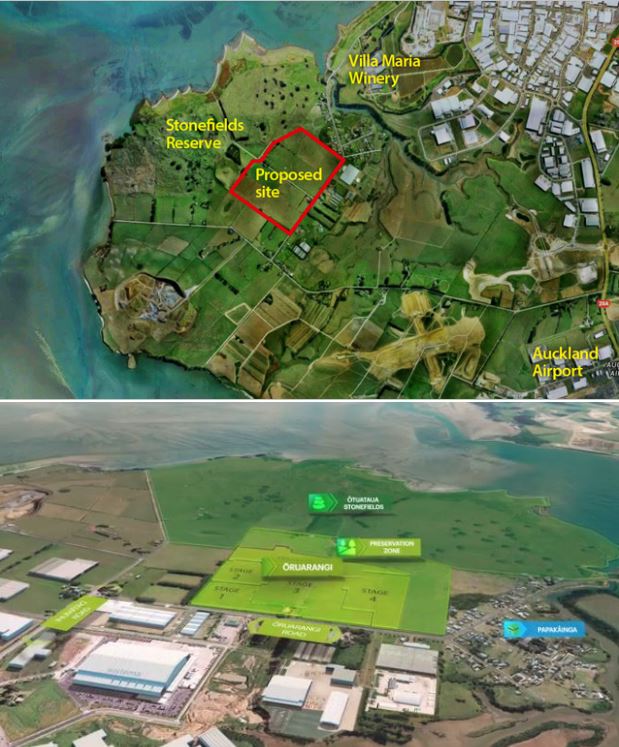
These findings are important because it is essential for a development to have correct, free and open consent from mana whenua before it can proceed. Dr Rawiri Taonui raised the possibility that ‘tāmana’ cash had been sprinkled by Fletcher Building, since its proposal included paying an undisclosed sum to the Makaurau Marae Māori Trust, as an Auckland Council Housing Accord consent hearing in 2015 evidently revealed. Fletcher Building stated that the Te Ākitai Waiohua and the Te Kawerau Iwi Authority and Makaurau Marae Māori Trust had completed Cultural Impacts Assessments for them. Yet, this cultural impact work seemed to have failed to factor in a predictable result – what would happen if the rest of the Makaurau Marae and papakāinga at Ihumātao found out that some in their community had written Cultural Impacts Assessments that furthered the Fletcher development without their knowledge?

Dianne Lee also alleges that Warren Taua has lived at a property that she bought in January 2008 – 517 Ōruarangi Road, Ihumātao in Mangere – for Mr Taua to lease. According to Lee, Taua evidently agreed to assign 4% of the iwi’s assets that he said his tribe were due to him for all his work for Te Kawerau ā Maki and that once the Treaty Settlement came through Lee would transfer the property to her, and she would get his 4% stake in the iwi’s assets. Lee also alleges that Taua has been in arrears of his rent for the Ōruarangi Road house at Ihumātao since 2011.
As Te Karere reported on 6 September 2019, Lee says that Mr Taua severed communications with her as soon as Te Kawerau ā Maki settled with the Crown, which was 22 February 2014. When it is recalled that Fletcher Building entered into a $19 million conditional sale agreement with Gavin H Wallace Limited for ‘the Wallace Block’ in March 2014, and this land was dutifully re-designated as a Special Housing Area (SHA) by the Auckland Council Development Committee in April 2014, and gazetted by Cabinet as SHA62 on 1 July 2014 – you have to wonder if Mr Taua, and others privy to his dealings with Tahi Enterprises, saw greener pastures could be developed with the Fletcher construction consortium. After-all, Taua has repeatedly defended his re-positioning decision to support the Fletcher Residential housing project at Ōruarangi, Ihumātao, saying he was forging a business partnership with a company that had the capacity to help the iwi house its people.
Side-show Saul: Environment Committee Chair Takes a Bribe
The Chairman of the Environment Committees for both the Makaurau Marae and Te Kawerau Iwi Tribal Authority, Saul Brendon Roberts, was convicted of fraud in March 2018 in the Auckland High Court. Roberts’ offending began when he was a trustee at Te Kawerau Iwi Tribal Authority in 2009.
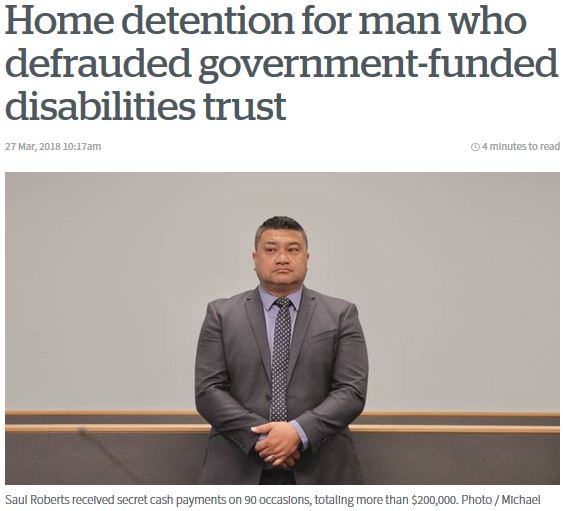
Among his convicted offences, one was for taking bribes of $40,000, while he was a trustee at Te Kawerau ā Maki Iwi Tribal Authority, from a company called Waterside Business Centre Ltd to withdraw opposition to an alteration to the Manukau District Plan related to land owned by Waterside. Roberts was convicted for five breaches of the Secret Commissions Act.
Given that Mr Roberts convictions occurred while he was the Chairman of the Environment Committees for both the Makaurau Marae and Te Kawerau Iwi Tribal Authority, and that his offending extended back to 2009, it stretches the suspension of belief one is normally required to partake in when watching, say, a Hollywood CIA movie like Mission Impossible or its British MI6 version, James Bond. Roberts’ accounting special FX weren’t too flash.
Because it seems the Establishment News Media’s news audiences were being asked to not only skip over questioning why Mr Roberts did not become a jail bird for his crimes. Especially given that he also defrauded a disabilities trust – which is getting to almost as a low as a trustee can go and worthy of a place on a ledge in a lower circle of Hell, if Dante Alighieri’s Inferno ever gets reworked into a modern-day Aotearoa/New Zealand epically divine comedy shot on location, in warehouses and composited in once-were-railways-engineering-sheds-but-now-upmarket-media-hubs-with retarded-brainwashed-wankers-for-clients. But the fact that Mr Roberts got home detention with an ankle bracelet appears to be more about keeping him monitored, homebound and nuisanceless – instead of being a jailbird where he could easily snitch to other jailbirds who know people who live in Ihumātao.
In light of Mr Roberts offending over approximately eight years – was this chairman of the Environment Committees for both the Makaurau Marae and Te Kawerau Iwi Tribal Authority, actually the scape-goat while accounts, emails, contractual documents and other records were ‘audited’? Did Dianne Lee’s persistence in pursuing Mr Taua through lawyers, force the N.Z. Order of Merit-Tāmaki Makaurau Collective Redress Deed-mandated kaumātua to ‘expose’ Saul Roberts for fraud, embezzlement and bribery, as a pretext for managing the fire that Lee was fuelling through the legal route? And did the fire that Lee lit also converge with the ahi kaa fire that ‘the six cousins’ sparked on the whenua at Puketapapa Ihumātao, especially since SOUL sought records from the Makaurau Marae Māori Trust and Te Kawerau Iwi Tribal Authority — an insolent move in Mr Taua’s eyes, that threatened to expose the precise details of Te Warena Taua’s dealings with Fletcher Building et al. In other words, did a purge of records occur under the cover of an investigation into Mr Roberts financial crimes to save the bigger fish — Warren Taua — from being fried in media-courtroom-paepae batter?
Where Out Thou, Man-dated Status?
Key Finding: SOUL’s four-year campaign amplified the risks for the mandated kaumātua that his secret deal with Tahi Enterprises would be exposed, and therefore, unravel his crucial support of the Fletcher Building project, catastrophically destroy his accumulation of power and forever shrink the merits of his life’s mahi for Te Kawerau ā Maki iwi.
To sum-up, the recent high profile exposure of Tahi Enterprises vs Te Warena Taua – Warren’s Other Protracted Dispute – by TVNZ‘s Te Karere News on Friday 6 September three hours after Snoopman News exposé, has not only opened up a can of settlement worms for the once were landless iwi, Te Kawerau ā Maki – whose ancestral territory in the Waitākere Region was bought from under them off other iwi by the Colonial Crown. Because the deal that mandated kaumātua Te Warena Taua of Te Kawerau ā Maki made with Dianne Lee of Tahi Enterprises in 2007-2008 potentially exposes the tribe to a far-reaching joint venture, the exposure of this simmering fight has raised the stakes for the parties associated with Te Warena Taua in their battle against SOUL. Tahi Enterprises claims they have a 35% stake in all the tribe’s future profits and 4% of its assets in return for funding the iwi’s Treaty settlements claims to the tune of $1.3 million. Te Kawerau ā Maki Iwi trustees claim Mr Taua had no mandate to contract, while they acknowledge Tahi advanced $1.3 million to their iwi to help their Waitangi Treaty settlement claims in exchange for joint venture rights. Te Kawerau ā Maki Tribal Authority trustees have been ordered by an Auckland High Court judge to make their register of their 400 members available for a viewing to Tahi Enterprises, who have to prove that the iwi members either consented or did not consent to the agreements that Te Warena Taua (and two others) made, evidentially claiming they had authority to make on their behalf.
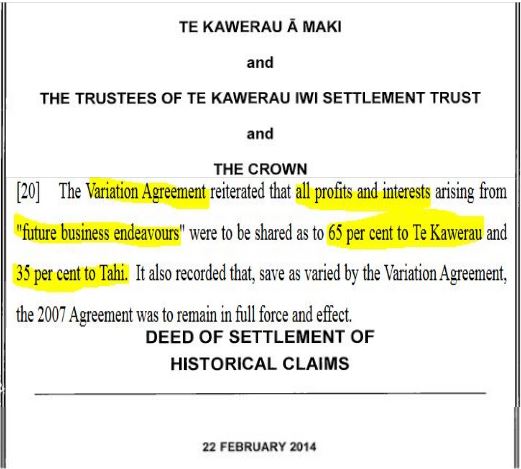
Mr Taua’s Silent Partner: Tahi Enterprises claim a 35% stake in all of Te Kawerau ā Maki iwi’s future profits and 4% of its assets in return for funding the iwi’s Treaty settlements claims to the tune of $1.3 million. [Editor’s Note: Court document of Tahia Enterprises agreement with Te Karerau is superimposed over Deed of Settlement for effect].
This secret Tahi-Taua deal was not known to the wider community of Ihumātao in Mangere, who are located across the Manukau Harbour from the Waitākere Forest. At Ihumātao, another protracted dispute over a Fletcher Building housing development on historically significant land confiscated by the Colonial in 1863 to 1866 — recently forced the Crown to intervene when thousands of supporters visited the tangata whenua-led occupation group, Save Our Unique Landscapes (SOUL), following an eviction order on July 23.
The contract agreement reached between Te Warena Taua and Dianne Lee reveals the subtext of Mr Taua’s illogical story that he could not fight the sale of the Wallace Block to Fletcher Building. What Mr Taua has serially-avoided saying is that the purchase and sale was conditional on gaining approval from numerous institutions to develop the now highly-disputed land. Te Warena Taua has long-said he is the mandated kaumātua and has given Fletcher Building the impression that Te Kawerau ā Maki is the local tribe of Ihumātao — and much of the news media and New Zealand as well. His avoidance to inform the two tribes with far-longer ancestral heritage at Makaurau Marae in Ihumātao — Te Ahiwaru Waiohua and Ngati Mahuta — and seek a mandate from the village to block Fletcher Building through various approval processes that still required iwi/hapū buy-in, now becomes more comprehensible and more reprehensible.

The capture of the mandated kaumātua from genuinely opposing rezoning of ‘the Wallace Block’ at Ōruarangi, Ihumātao in 2012, to secretly being drawn into the orbit of the transnational bank-controlled Fletcher Building consortium before February 2015 – encountered an obstacle more formiddable than all the colluding parties imagined. This obstacle was – and remains – SOUL, formed by the six defiant cousins in 2015, to oppose the development. The whenua protection pact reached over a dinner one night in mid-to-late 2014, and the subequent hui at Makaurau Marae in February 2015, led directly to Pania Newton’s pivotal and ballsy decision to lead the occupation of the endangered whenua from her newly-purchased, light blue and white vintage 12-footer caravan.
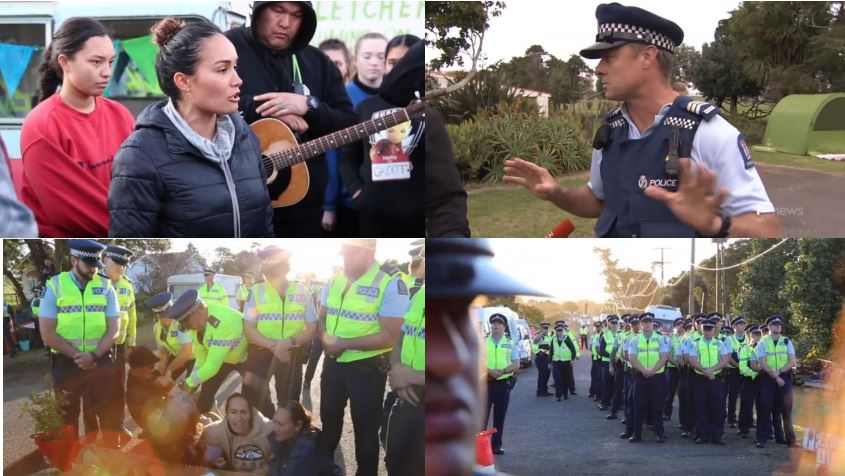
It would appear Mr Taua has reneged on a joint venture deal that was reached with Tahi Enterprises, but without consulting his own iwi, Te Kawerau ā Maki. The New Zealand Order of Merit recipient subsequently supported the Fletcher Building consortium’s housing project, without consulting the mana whenua at Makaurau Marae in Ihumātao Village – Te Ahiwaru Waiohua and Ngati Mahuta. In other words, SOUL’s physical obstruction of the Fletcher Residential housing project through occupation may well have complicated Mr Taua’s distancing with Tahi Enterprises, and prolonged his own occupation of the Ōruarangi Rd house property bought by Dianne Lee in January 2008 for Mr Taua to reside in, from where he could have ‘an ear’ to the ground. Because the Protect Ihumātao occupation has been four years in duration, Mr Taua’s strategy may have been to drag out the dispute with Tahi in the hopes that Dianne Lee would give up amid mounting legal fees, an understandable reluctance to escalate the dispute in the public arena – thereby losing anonymity – and risking a backlash from the iwi for having entered a joint venture deal of such far-reaching magnitude without meeting the tribe first. The complication for Mr Taua of the six defiant cousins appears to go along way to explain not only the deep irritation Mr Taua has felt about their so-called unmandated group – SOUL – and why he has been so dismissive of his niece, Pania Newton. It may also go along way to explaining the raw nerve visibly struck when he was asked on TVNZ’s Marae in April 2019 why he seemed to be the only Māori figure opposed to SOUL’s campaign. In light of the Tahi Enterprises Scandal, the complication for Mr Taua of the six defiant cousins appears to go along way to explain the deep irritation the ‘mandated’ kaumātua has felt about their so-called unmandated group – SOUL – and why he has been so dismissive of his niece, Pania Newton.

As Te Karere reported on 5 September 2019, Lee says that Mr Taua severed communications with her as soon as Te Kawerau ā Maki settled with the Crown, which was 22 February 2014. When it is recalled that Fletcher Building entered into a $19 million conditional sale agreement with Gavin H Wallace Limited for ‘the Wallace Block’ in March 2014, and this land was dutifully re-designated as a Special Housing Area (SHA) by the Auckland Council Development Committee in April 2014, and gazetted by Cabinet as SHA62 on 1 July 2014 – you have to wonder if Mr Taua, and others privy to his dealings with Tahi Enterprises, saw greener pastures could be developed with the Fletcher construction consortium. After-all, he has repeatedly defended his re-positioning decision to support the Fletcher Residential housing project at Ōruarangi, Ihumātao, saying he was forging a business partnership with a company that had the capacity to help the iwi house its people.

In his Waatea News article, “Ihumātao | Tangata Whenua vs Mana Whenua”, Dr Rawiri Taonui wrote that Makaurau Marae Māori Trust Chairman Te Warena Taua “was instrumental in negotiating a compromise that facilitated the advancement of the Fletcher proposal through the Auckland Council, Heritage New Zealand and the Environmental Court.”
If so, in what capacity? Was it as chairman of Te Kawerau ā Maki Iwi Tribal Authority, or as chairman of Te Kawerau ā Maki Iwi Tribal Authority Settlement Authority or chairman of Makaurau Marae Māori Trust?
And was it really a compromise? Or was it that the political, commercial and bureacratorial élite of Auckland and Wellington learned that the mandated kaumatua was compromised? Particularly as his connection with Tahi Enterprises ended so abruptly, the large sums lent to an iwi authority – before the tribe had reached a Treaty settlement – did not subsequently yield the growing joint venture activities you would expect to see in metadata such as communications, transactions, legal documents, planning applications, and consent approvals and the conspicuous absence of Dianne Lee and her husband at iwi events – before and after settlement.

While Mr Taua was chairing three committees across three iwi/hapū groups on one marae, the chairman of two Environment Committee’s – one at Makaurau Marae and the other at Te Kawerau Iwi Tribal Authority – Saul Brendon Roberts, was embezzling monies, committing fraud and taking bribe payments.
Because Saul Roberts took several bribe payments, I believe it is reasonable to ask Mr Taua if he accepted a bribe from Fletcher Building, or associated entities, or individuals. Given his capitulation to the Fletcher development after forty years of fighting the Crown, Councils, and Corporates, I believe it is reasonable to ask Mr Taua if he accepted a bribe from Fletcher Building, or associated entities, or individuals. Given that Mr Taua decided without calling a big hui at Makaurau Marae before he decided to work with Fletcher Building and meanwhile unbeknown to his own iwi – Te Kawerau ā Maki – he had, five or so years before, entered a credit and assets agreement with a company that will likely embroil his iwi in a bitter dispute because the iwi’s own trustees deny Mr Taua had a right to contract – I believe it is reasonable to ask Mr Taua if he accepted a bribe from Fletcher Building, or associated entities, or individuals.
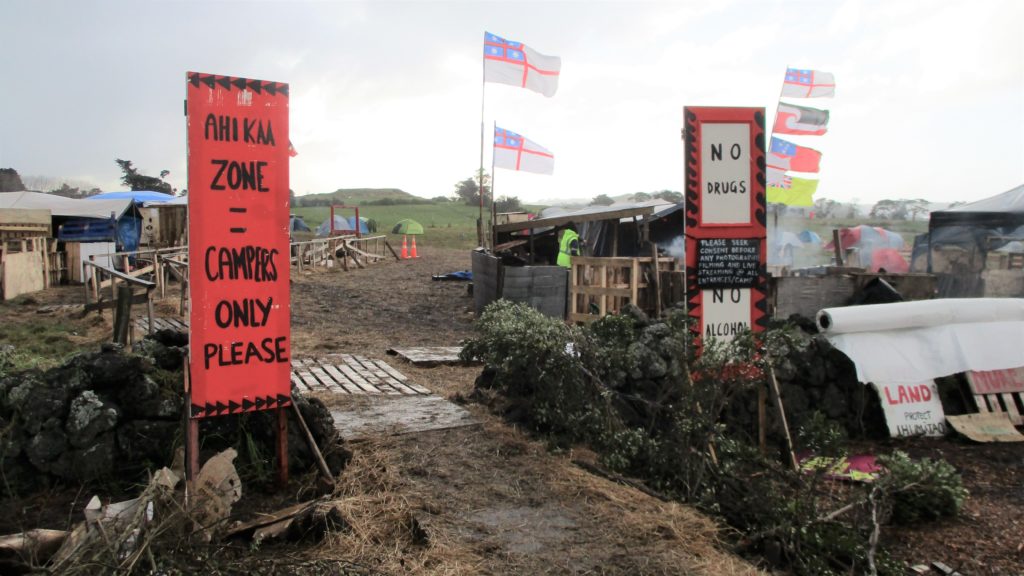
It is also rather strange when it is remembered that Te Warena Taua has standing as the top kaumatua of Te Kawerau ā Maki, and his iwi was included in the Tāmaki Makaurau Collective Redress Deed (2012) – while he had also been living in a house in Ihumātao village owned by Dianne Lee since 2008. Strange not only because of the secret agreement with Tahi Enterprises. But, also strange given that Makaurau Marae is Te Ahiwaru Waiohua and Ngati Mahuta, and through inter-marriage, Pukaki Marae, which is Te Akitai Waiohua, are also mana whenua at Ihumātao. Strange because Te Ahiwaru Waiohua and Ngati Mahuta were excluded from the 13 tribes that the Auckland Council and the Crown recognise as mana whenua in Tāmaki Makaurau. You would have thought that Te Warena Taua would have made a call loud and clear to hui so that Te Ahiwaru Waiohua and Ngati Mahuta would not be left out of the Tāmaki Makaurau Collective Redress Deed of 2012, since Te Warena Taua boasts he is the mandated kaumatua with mana whenua standing at Makaurau Marae.
Recall what Te Warena Taua said on TVNZ’s Marae in April 2019?
“Half of Ihumatao are Te Kawerau a Maki. My people support me. SOUL as a group that has no mana. At the end of the day, they do not speak for the whole village. Do I speak for the whole village? No. Only for those who’d like me to speak for them. I’m mandated, they are not.”
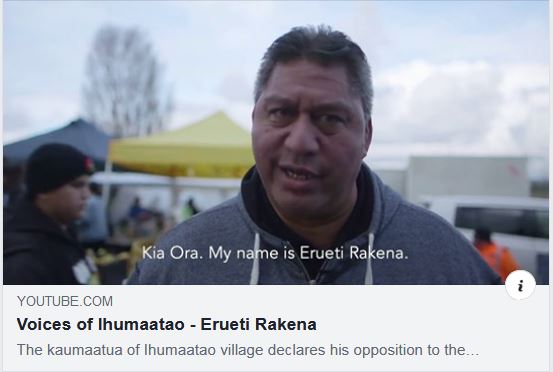
The mandated status that Mr Taua has expressed appeared to come disproportionately from his role as Chairman of Te Kawaerau ā Maki Iwi Tribal Authority and Te Kawerau ā Maki Settlement Trust and, therefore, as the leading kaumatua of one of only 13 mana whenua groups in the 2012 Tāmaki Makaurau Collective Redress Deed which was mandated and recognised by the Crown in 2014. In other words, Mr Taua has sounded more like a self-appointed bipartisan political appointee chairing the Makaurau Marae Māori Trust, than a kaumatua responsibly seeking mandates from the whole papakiānga – whose ancestors accepted members of his iwi into their community in the early 20th Century.
But, then, with sunlight on his other protracted dispute, Mr Warren Taua’s insistance that his mandated kaumātua status trumps the six cousins’ unmandated whenua protection squad – Save Our Unique Landscapes – looks more the like rituals of animosity that belie a classic holdfast ego character who need for power on the reservation has become a matter of self-preservation. This would explain why Mr Taua’s attempt to have the other the three dissenting committee members of the Makaurau Marae Maori Trust ejected in the Auckland High Court on Friday 6 September 2019 went awry following Te Karere’s exposure of the Tahi Enterprises Scandal the day before.
What was intended to be a lucrative housing project that excluded public consultation through the all-important Special Housing Area zoning, turned into a four-year fight that errupted into a national story of historical significance for having opened up space for conversations all over the country. The SOUL campaign has not only revealed the huge complication it presented for Mr Taua’s secret deal with Tahi Enterprises, his own dealings with Fletcher Building, and his alignments with other players. SOUL’s Protect Ihumātao campaign to save the Ōruarangi Block in Ihumātao from destruction, has begun to shift the ground around the Neo-Colonial Crown, its Pākehā-Dominated fraternal friend, the Auckland Council, and their equally-institutionalized, politely racist friends in Her Majesty’s Neo-Colonial Courts and even the Kiingitanga élite of Waikato-Tainui.
Therefore, the key finding of this exposé is SOUL’s four-year campaign amplified the risks for the mandated kaumātua that his secret deal with Tahi Enterprises would be exposed, and therefore, unravel his crucial support of the Fletcher Building project, catastrophically destroy his accumulation of power and forever shrink the merits of his life’s mahi for Te Kawerau ā Maki iwi.
Editor’s Note: Please let me know if I have made any errors, or if you have further relevant information or supporting records. e: steveedwards555@gmail.com
Referenced Sources:
The Queen vs Saul Brendon Roberts
R v ROBERTS [2018] NZHC 548 [27 March 2018]
https://forms.justice.govt.nz/search/Documents/pdf/jdo/72/alfresco/service/, Jusdtice api/node/content/workspace/SpacesStore/afecf7b7-edda-457c-bbab-d32ef628b3d6/afecf7b7-edda-457c-bbab-d32ef628b3d6.pdf

